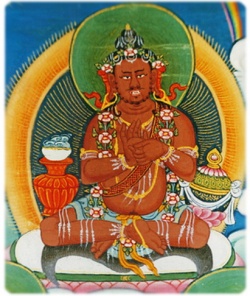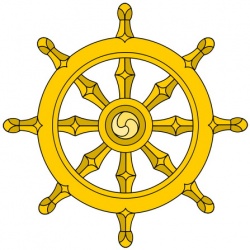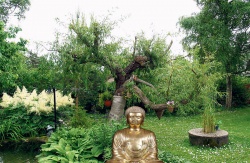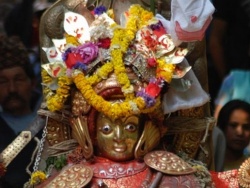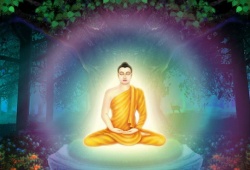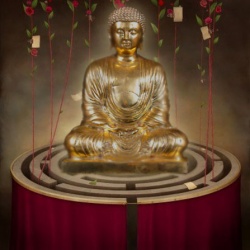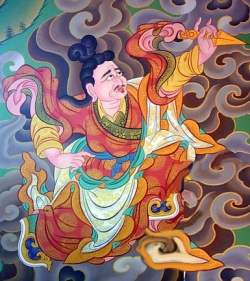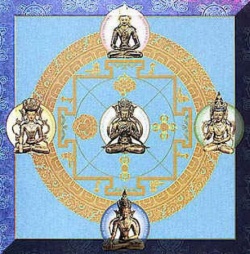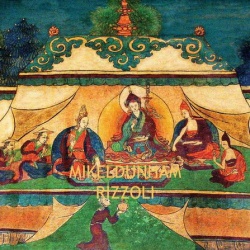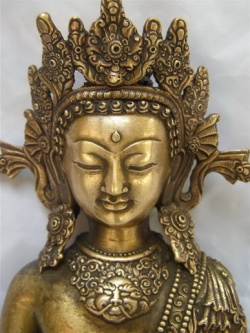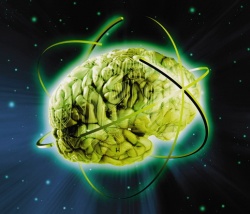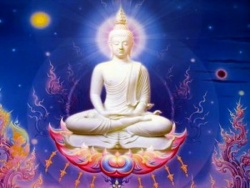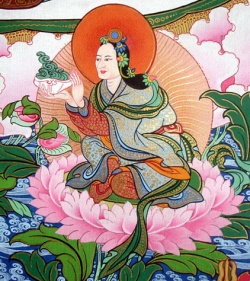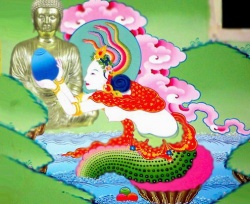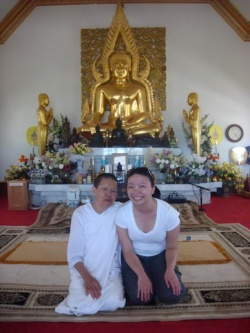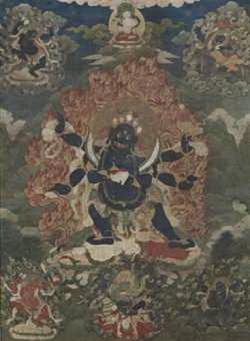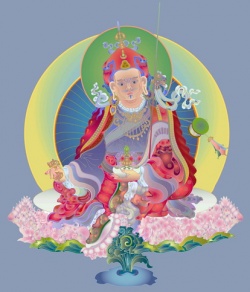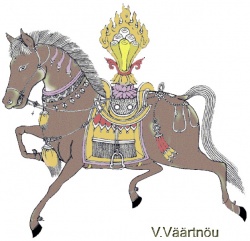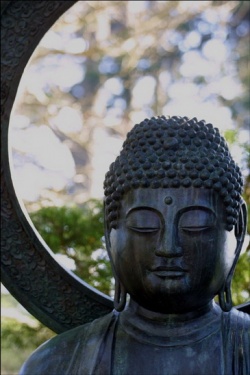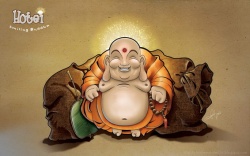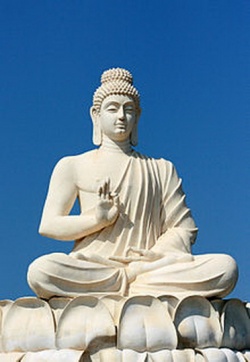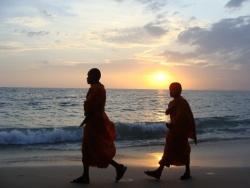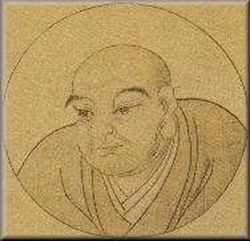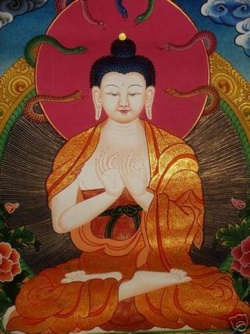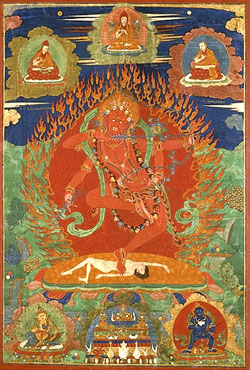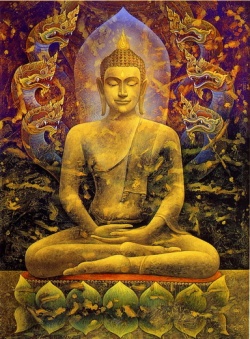Difference between revisions of "Ultimate and Relative"
| Line 20: | Line 20: | ||
[[Nagarjuna]] says, "The [[elements]] do not themselves [[exist]] individually, | [[Nagarjuna]] says, "The [[elements]] do not themselves [[exist]] individually, | ||
So how could their [[own]] {{Wiki|individual}} characters [[exist]]? | So how could their [[own]] {{Wiki|individual}} characters [[exist]]? | ||
| − | What do not themselves | + | What do not themselves individually [[exist]] cannot predominate. |
Their characters are regarded as conventionalities. | Their characters are regarded as conventionalities. | ||
| Line 35: | Line 35: | ||
Why? What dependently originates, what is composite, is utterly [[empty]]. | Why? What dependently originates, what is composite, is utterly [[empty]]. | ||
| − | What you call a car is simply a label [[imputed]] on a composite that via [[dependent origination]] leads to a [[function]] or [[activity]] called 'driving'. In [[actuality]] the composite is [[empty]] of anything that can be pinned down as a 'car'. Actually there is no car, just like there is no | + | What you call a car is simply a label [[imputed]] on a composite that via [[dependent origination]] leads to a [[function]] or [[activity]] called 'driving'. In [[actuality]] the composite is [[empty]] of anything that can be pinned down as a 'car'. Actually there is no car, just like there is no weatherness of weather, and so on. It is just a conventionality that has no [[truth]] in it, but is nonetheless used for convenient [[communication]]. When [[emptiness]] is [[realized]], all [[signs]] cease and [[nirvana]] is [[attained]] in the [[manner]] [[Chandrakirti]] explains: The very coming to rest, the non-functioning, of [[perceptions]] as [[signs]] of all named things, is itself [[nirvana]]. |
| − | |||
| − | + | Such a [[state]] is described by the [[Buddha]] in the [[Kalaka Sutta]]: | |
| + | |||
| + | |||
| + | [[Nagarjuna says]], | ||
| + | |||
Whatever is dependently co-arisen, | Whatever is dependently co-arisen, | ||
| Line 73: | Line 76: | ||
"And so, [[Anuradha]] — when you can't pin down the [[Tathagata]] as a [[truth]] or [[reality]] even in the {{Wiki|present}} [[life]] — is it proper for you to declare, 'Friends, the [[Tathagata]] — the supreme man, the superlative man, attainer of the superlative [[attainment]] — being described, is described otherwise than with these four positions: The [[Tathagata]] [[exists]] after [[death]], does not [[exist]] after [[death]], both does & does not [[exist]] after [[death]], [[neither exists]] nor does not [[exist]] after [[death]]'?" | "And so, [[Anuradha]] — when you can't pin down the [[Tathagata]] as a [[truth]] or [[reality]] even in the {{Wiki|present}} [[life]] — is it proper for you to declare, 'Friends, the [[Tathagata]] — the supreme man, the superlative man, attainer of the superlative [[attainment]] — being described, is described otherwise than with these four positions: The [[Tathagata]] [[exists]] after [[death]], does not [[exist]] after [[death]], both does & does not [[exist]] after [[death]], [[neither exists]] nor does not [[exist]] after [[death]]'?" | ||
| − | First things first -- [[truths]] (satyas) are [[objects]] of [[cognitions]] -- which can be either correct ([[Wikipedia:Absolute (philosophy)|ultimate]]) or false ([[relative]]). Since you are studying [[Gelug]] influenced {{Wiki|discourse}}, this may not be immediately evident to you. | + | First things first -- [[truths]] ([[satyas]]) are [[objects]] of [[cognitions]] -- which can be either correct ([[Wikipedia:Absolute (philosophy)|ultimate]]) or false ([[relative]]). Since you are studying [[Gelug]] influenced {{Wiki|discourse}}, this may not be immediately evident to you. |
This means that if you see something that you identify as [[salt]], and it functions as [[salt]], this [[cognition]] is true in so far as it is efficient. | This means that if you see something that you identify as [[salt]], and it functions as [[salt]], this [[cognition]] is true in so far as it is efficient. | ||
| Line 80: | Line 83: | ||
A [[relative truth]] is the [[subject]] of a [[cognition]] that is not in possession of the fact that the given apparent [[phenomena]] being [[perceived]] as an [[object]] of said [[cognition]] lacks the [[Wikipedia:Identity (social science)|identity]] [[imputed]] to it. An [[ultimate truth]] is an [[object]] of a cogniton which is in possession of the fact that the given apparent [[phenomena]] being [[perceived]] as an [[object]] of said [[cognition]] lacks the [[Wikipedia:Identity (social science)|identity]] [[imputed]] to it and does not {{Wiki|perceive}} the [[Wikipedia:Identity (social science)|identity]] which is {{Wiki|non-existent}} in that [[object]] of [[cognition]]. | A [[relative truth]] is the [[subject]] of a [[cognition]] that is not in possession of the fact that the given apparent [[phenomena]] being [[perceived]] as an [[object]] of said [[cognition]] lacks the [[Wikipedia:Identity (social science)|identity]] [[imputed]] to it. An [[ultimate truth]] is an [[object]] of a cogniton which is in possession of the fact that the given apparent [[phenomena]] being [[perceived]] as an [[object]] of said [[cognition]] lacks the [[Wikipedia:Identity (social science)|identity]] [[imputed]] to it and does not {{Wiki|perceive}} the [[Wikipedia:Identity (social science)|identity]] which is {{Wiki|non-existent}} in that [[object]] of [[cognition]]. | ||
| + | |||
The [[function]] of the [[two truths]] is to lead to the [[cessation]] of {{Wiki|proliferation}} about [[Wikipedia:Identity (social science)|identity]]. The lack of [[Wikipedia:Identity (social science)|identity]] within [[phenomena]] and persons alone is [[emptiness]] and nothing else. | The [[function]] of the [[two truths]] is to lead to the [[cessation]] of {{Wiki|proliferation}} about [[Wikipedia:Identity (social science)|identity]]. The lack of [[Wikipedia:Identity (social science)|identity]] within [[phenomena]] and persons alone is [[emptiness]] and nothing else. | ||
| + | |||
The [[Reason]] to [[Meditate]] on the [[Right View]] | The [[Reason]] to [[Meditate]] on the [[Right View]] | ||
| Line 88: | Line 93: | ||
You cannot cut the [[root cause]] of circling. | You cannot cut the [[root cause]] of circling. | ||
Therefore, attempt the method to realize [[dependent arising]]. | Therefore, attempt the method to realize [[dependent arising]]. | ||
| + | |||
Showing the [[Right View]] | Showing the [[Right View]] | ||
| + | |||
| + | |||
[10] One who sees the [[cause and effect]] of all [[phenomena]] | [10] One who sees the [[cause and effect]] of all [[phenomena]] | ||
Of both [[cyclic existence]] and the [[state]] beyond [[sorrow]] as forever unbetraying, | Of both [[cyclic existence]] and the [[state]] beyond [[sorrow]] as forever unbetraying, | ||
| Line 114: | Line 122: | ||
Then you are not captivated by wrong notions holding extreme [[views]]. | Then you are not captivated by wrong notions holding extreme [[views]]. | ||
| − | In order to comprehend clearly the [[supramundane]] plane, we have to know first about its opposite, the [[mundane]] plane ([[Lokiyabhumi]]). The [[mundane]] plane comprises those levels at which the things of the [[world]] have control over the [[mind]]. Very briefly, three levels are [[recognized]] in the [[mundane]] plane, namely: the [[sensual level]] ([[Kamavacara-bhumi]]), or the level of a [[mind]] still content with [[pleasures]] of every kind; the level of [[forms]] (Rupavacara-bhumi), the [[condition]] of a [[mind]] uninterested in [[sensual objects]], but finding [[satisfaction]] in the various stages of [[concentration]] on [[forms]] as [[objects]]; and lastly the [[formless]] level ([[Arupavacara-bhumi]]), the yet higher level of a [[mind]] finding [[satisfaction]] in the [[bliss]] and [[peace]] of [[concentration]] on [[objects]] other than [[forms]]. These three levels in the [[worldly]] plane are the [[mental]] levels of [[beings]] in general. Regardless of whether we presume to call them [[human beings]], [[celestial beings]], [[gods]], {{Wiki|beasts}}, or denizens of [[hell]], they are all included within the three [[worldly]] levels. The [[mind]] of a [[worldling]] can at any particular [[time]] [[exist]] in any one of these three. It is not impossible. It is quite normal. As a {{Wiki|rule}}, though, it will tend to fall back naturally to the unconcentrated [[sensual level]]; the [[human]] [[mind]] normally falls under the influence of the delightful in colors and shapes, {{Wiki|sounds}}, {{Wiki|odors}}, {{Wiki|tastes}} and {{Wiki|tactile}} [[objects]]. Only on certain occasions is it able to escape from the influence of these {{Wiki|seductive}} things and [[experience]] the [[tranquillity]] and [[bliss]] which comes from practicing [[concentration]] on [[forms]] or other [[objects]]. It all depends on [[concentration]]. At certain times, then, a person's [[mind]] may be located in any of these levels of [[concentration]]. In [[India]] at the [[time]] of the [[Buddha]] this must have been fairly common, because [[people]] who had gone in search of the [[tranquillity]] and [[bliss]] associated with the various levels of [[concentration]] were to be found living in forests all over the country. At the {{Wiki|present}} [[time]] such [[people]] are few, but it is nevertheless possible for the [[ordinary man]] to attain these levels. If someone in this [[world]] is in the process of experiencing the [[bliss]] of [[full concentration]] on a [[form]], then for him "the [[world]]" consists of just that [[form]], because he is {{Wiki|aware}} of nothing else. At that [[time]] and for that [[person]], "the [[world]]" is {{Wiki|equivalent}} to just that one [[form]], and it remains so until such [[time]] as his [[mental]] [[condition]] changes. | + | In order to comprehend clearly the [[supramundane]] plane, we have to know first about its opposite, the [[mundane]] plane ([[Lokiyabhumi]]). The [[mundane]] plane comprises those levels at which the things of the [[world]] have control over the [[mind]]. Very briefly, three levels are [[recognized]] in the [[mundane]] plane, namely: the [[sensual level]] ([[Kamavacara-bhumi]]), or the level of a [[mind]] still content with [[pleasures]] of every kind; the level of [[forms]] ([[Rupavacara-bhumi]]), the [[condition]] of a [[mind]] uninterested in [[sensual objects]], but finding [[satisfaction]] in the various stages of [[concentration]] on [[forms]] as [[objects]]; and lastly the [[formless]] level ([[Arupavacara-bhumi]]), the yet higher level of a [[mind]] finding [[satisfaction]] in the [[bliss]] and [[peace]] of [[concentration]] on [[objects]] other than [[forms]]. These three levels in the [[worldly]] plane are the [[mental]] levels of [[beings]] in general. Regardless of whether we presume to call them [[human beings]], [[celestial beings]], [[gods]], {{Wiki|beasts}}, or denizens of [[hell]], they are all included within the three [[worldly]] levels. The [[mind]] of a [[worldling]] can at any particular [[time]] [[exist]] in any one of these three. It is not impossible. It is quite normal. As a {{Wiki|rule}}, though, it will tend to fall back naturally to the unconcentrated [[sensual level]]; the [[human]] [[mind]] normally falls under the influence of the delightful in colors and shapes, {{Wiki|sounds}}, {{Wiki|odors}}, {{Wiki|tastes}} and {{Wiki|tactile}} [[objects]]. Only on certain occasions is it able to escape from the influence of these {{Wiki|seductive}} things and [[experience]] the [[tranquillity]] and [[bliss]] which comes from practicing [[concentration]] on [[forms]] or other [[objects]]. It all depends on [[concentration]]. At certain times, then, a person's [[mind]] may be located in any of these levels of [[concentration]]. In [[India]] at the [[time]] of the [[Buddha]] this must have been fairly common, because [[people]] who had gone in search of the [[tranquillity]] and [[bliss]] associated with the various levels of [[concentration]] were to be found living in forests all over the country. At the {{Wiki|present}} [[time]] such [[people]] are few, but it is nevertheless possible for the [[ordinary man]] to attain these levels. If someone in this [[world]] is in the process of experiencing the [[bliss]] of [[full concentration]] on a [[form]], then for him "the [[world]]" consists of just that [[form]], because he is {{Wiki|aware}} of nothing else. At that [[time]] and for that [[person]], "the [[world]]" is {{Wiki|equivalent}} to just that one [[form]], and it remains so until such [[time]] as his [[mental]] [[condition]] changes. |
Even though a [[person]] dwelling in any of these three levels may have gained such [[bliss]] and [[calm]] [[tranquillity]] that he has come to resemble a rock, a lump of [[earth]], or a log of [[wood]], yet [[grasping]] and [[clinging]] to [[selfhood]] are still {{Wiki|present}}. Also {{Wiki|present}} are various kinds of [[desire]], albeit of the finest and most tenuous sort, such as [[dissatisfaction]] with the [[state]] in which he finds himself, which prompts him to go in search of a new [[state]]. That [[desire]] for change constitutes [[karma]], so such a [[person]] has not yet transcended the [[worldly]] [[state]]. He is not yet in the [[supramundane]] plane. A [[mind]] dwelling in the [[supramundane]] plane has transcended the [[world]]. It [[views]] the [[worldly]] [[state]] as devoid of [[essence]], [[self]], or [[substance]], and will have nothing of it. | Even though a [[person]] dwelling in any of these three levels may have gained such [[bliss]] and [[calm]] [[tranquillity]] that he has come to resemble a rock, a lump of [[earth]], or a log of [[wood]], yet [[grasping]] and [[clinging]] to [[selfhood]] are still {{Wiki|present}}. Also {{Wiki|present}} are various kinds of [[desire]], albeit of the finest and most tenuous sort, such as [[dissatisfaction]] with the [[state]] in which he finds himself, which prompts him to go in search of a new [[state]]. That [[desire]] for change constitutes [[karma]], so such a [[person]] has not yet transcended the [[worldly]] [[state]]. He is not yet in the [[supramundane]] plane. A [[mind]] dwelling in the [[supramundane]] plane has transcended the [[world]]. It [[views]] the [[worldly]] [[state]] as devoid of [[essence]], [[self]], or [[substance]], and will have nothing of it. | ||
| Line 126: | Line 134: | ||
What we have to do is lead the kind of [[life]] described as [[Right Living]] ([[Samma]] Vihareyyum), and be full day and night with the [[joy]] that arises out of conduct that is consistently good, beautiful and right. This limits [[aimless wandering]] of the [[thoughts]] and makes it possible to [[concentrate]] and to have clear [[insight]] at all times. Then if [[conditions]] are right, the result is disenchantment, struggle to break loose, slipping free, or even complete [[Nirvana]]. | What we have to do is lead the kind of [[life]] described as [[Right Living]] ([[Samma]] Vihareyyum), and be full day and night with the [[joy]] that arises out of conduct that is consistently good, beautiful and right. This limits [[aimless wandering]] of the [[thoughts]] and makes it possible to [[concentrate]] and to have clear [[insight]] at all times. Then if [[conditions]] are right, the result is disenchantment, struggle to break loose, slipping free, or even complete [[Nirvana]]. | ||
| − | [[Candrakirti]] very specificially says "[[yang dag | + | [[Candrakirti]] very specificially says "[[yang dag mthong yul gang de de nyid de]]" i.e. "Any [[object]] [yul] of a correct ([[yang dag]]) [[perception]] ([[mthong]]) that is real ([[de nyid]])" i.e. an [[ultimate truth]]. The he says [[mthong ba brdzun pa kun rdzob bden par gsungs]] i.e. "[The [[object]] of] a false [[perception]] is a [[relative truth]]." |
He also specfies very precisely just before these two lines: | He also specfies very precisely just before these two lines: | ||
| − | /dngos kun | + | /[[dngos kun yang dag brdzun pa mthong ba yis]]/ /[[dngos rnyed ngo bo gnyis ni 'dzin par 'gyur]] |
"Since all things are [[perceived]] correctly and falsely; | "Since all things are [[perceived]] correctly and falsely; | ||
| Line 143: | Line 151: | ||
The {{Wiki|Theory}} of [[Two Truths]] in [[Tibet]] | The {{Wiki|Theory}} of [[Two Truths]] in [[Tibet]] | ||
| − | [[Tibetan]] [[philosophers]] argue that the [[two truths]] {{Wiki|theory}} is not only core [[Wikipedia:Ontology|ontological]] [[doctrine]] as it is understood within the [[Indian]] [[Buddhist]] [[thought]], it also makes the central {{Wiki|theory}} behind epistemology and {{Wiki|soteriology}}. The [[Indian Buddhist schools]] are named after the theories of the [[two truths]] they each upheld as in the entry on the {{Wiki|theory}} of the [[two truths]] in [[India]]. The same cannot be said about the schools of [[thought]] in [[Tibet]]. All [[Tibetan]] [[philosophers]] and the schools[1]—[[Nyingma]], [[Kagyü]], [[Sakya]], and | + | [[Tibetan]] [[philosophers]] argue that the [[two truths]] {{Wiki|theory}} is not only core [[Wikipedia:Ontology|ontological]] [[doctrine]] as it is understood within the [[Indian]] [[Buddhist]] [[thought]], it also makes the central {{Wiki|theory}} behind epistemology and {{Wiki|soteriology}}. The [[Indian Buddhist schools]] are named after the theories of the [[two truths]] they each upheld as in the entry on the {{Wiki|theory}} of the [[two truths]] in [[India]]. The same cannot be said about the schools of [[thought]] in [[Tibet]]. All [[Tibetan]] [[philosophers]] and the schools[1]—[[Nyingma]], [[Kagyü]], [[Sakya]], and [[Gelug]]—they established are self-confessed followers of the [[Prāsaṅgika]] [[Madhyamaka school]] of [[thought]], and follow [[Candrakīrti]] closely. [[Tibetans]] agree that [[Candrakīrti]] is the undisputed authority in commenting and interpreting [[Nāgārjuna's]] [[Madhyamaka]] {{Wiki|theory}} of the [[two truths]]. The [[Tibetan]] [[Prāsaṅgikas]] however disagreed, [[debated]] and fought fiercely amongst themselves concerning many [[philosophical]] questions. Who is the [[Prāsaṅgika]]? Does the [[Prāsaṅgika]] hold any position? What is it that constitutes the [[Prāsaṅgika's]] core [[philosophical]] position? How should [[Candrakīrti's]] {{Wiki|hermeneutic}} approach towards [[Nāgārjuna]] be assessed, evaluated and interpreted? The [[debate]] amongst the [[Tibetan]] [[philosophers]] stems on a large part from the way in which they each differently interpreted and understood [[Candrakīrti's]] {{Wiki|theory}} of the [[two truths]] and its [[philosophical]] implications. The parameters within which this [[debate]] is conducted either in the [[monastic]] [[debate]] courtyards or in their [[philosophical]] writings, took a [[form]] around certain [[philosophical]] themes. Those themes later became the standard paradigmatic focus of any [[discussion]] on the [[subject]] of the [[two truths]]. |
Basis of the [[division]]: What is divided into the [[two truths]]? | Basis of the [[division]]: What is divided into the [[two truths]]? | ||
| Line 156: | Line 164: | ||
1. [[Nyingma]] | 1. [[Nyingma]] | ||
| − | [[Longchen Rabjam]] sets out the course of the [[Nyingma]] {{Wiki|theory}} of the [[truths]] and the later [[philosophers]] of the school took similar stance without varying much in [[essence]]. In [[Treasure]] he begins the section on the [[Madhyamaka]] {{Wiki|theory}} of the [[two truths]] as follows: “The [[Madhyamaka | + | [[Longchen Rabjam]] sets out the course of the [[Nyingma]] {{Wiki|theory}} of the [[truths]] and the later [[philosophers]] of the school took similar stance without varying much in [[essence]]. In [[Treasure]] he begins the section on the [[Madhyamaka]] {{Wiki|theory}} of the [[two truths]] as follows: “The [[Madhyamaka tradition]] is the secret and profound teachings of the [[Śākya]mūni]]. Although it constitues five [[Wikipedia:Ontology|ontological]] categories, the [[two truths]] subsume them.” ([[Longchen]], 1983: 204f) |
| + | |||
| + | [[Nyingma]] defines [[conventional truth]] as consisting of unreal [[phenomena]] that appear to be real to the erroneous [[Wikipedia:cognition|cognitive]] {{Wiki|processes}} of the [[ordinary beings]] while [[ultimate truth]] is [[reality]] which {{Wiki|transcends}} any mode of [[thinking]] and {{Wiki|speech}}, one that unmistakenly appears to the nonerroneous [[Wikipedia:cognition|cognitive]] {{Wiki|processes}} of the [[exalted]] and [[awakened]] [[beings]]. | ||
| + | |||
| + | In other words | ||
| − | + | (1) [[ultimate truth]] represents the {{Wiki|perspective}} of epistemically correct and warranted [[Wikipedia:cognition|cognitive]] process of [[exalted]] [[beings]] (‘[[phags pa]]); | |
| − | Let us consider these two definitions turn by turn. [[Nyingma]] supports [[definition]] (1) with two premises. The first one says that [[Wikipedia:cognition|cognitive]] {{Wiki|processes}} of the [[exalted]] (‘[[phags pa]]) and [[awakened]] [[beings]] ([[sang | + | whereas (2) [[conventional truth]] represents the {{Wiki|perspective}} of epistemically deceptive and unwarranted [[Wikipedia:cognition|cognitive]] {{Wiki|processes}} of the [[ordinary beings]]. |
| + | |||
| + | |||
| + | ([[Mipham Rinpoche]] 1993d: 543–544) | ||
| + | |||
| + | |||
| + | Let us consider these two definitions turn by turn. [[Nyingma]] supports [[definition]] (1) with two premises. The first one says that [[Wikipedia:cognition|cognitive]] {{Wiki|processes}} of the [[exalted]] (‘[[phags pa]]) and [[awakened]] [[beings]] ([[sang rgyas]]) are epistemically correct and [[non-deceptive]], because “It is in [[relation]] to this [[Wikipedia:cognition|cognitive]] content that the realisation of [[the ultimate truth]] is so designated. The [[object]] of an [[exalted]] [[Wikipedia:cognition|cognitive]] process consists of [[the way things really are]] ([[gshis kyi gnas lugs]]), [[phenomena]] as they really are ([[chos kyi dbyings]]) which is undefiled by its very [[nature]] ([[rang bzin dag pa]]).” | ||
| + | |||
| + | ([[Longchen]] 1983: 202f) However [[ultimate truth]] for [[Nyingma]] is not an [[object]] [[per se]] in the usual [[sense]] of the [[word]]. It is [[object]] only in the {{Wiki|metaphorical}} [[sense]]. “From the Wikipedia:Absolute (philosophy)|ultimate]] {{Wiki|perspective}} the [[meditative equipoise]] of the realised (sa thob) and [[awakened]] [[beings]] ([[sangs rgyas]]), there [[exists]] neither [[object of knowledge]] ([[shes bya]]) nor [[knowing]] [[Wikipedia:cognition|cognitive]] process ([[shes byed]]) and so forth, for there is neither [[object]] to apprehend nor the [[subject]] that does the apprehending. Even the [[exalted]] [[Wikipedia:cognition|cognitive]] process (yeshes) as a [[subject]] ceases ([[zhi ba]]) to operate.” ([[Longchen]] 1983: 201f) Therefore “At this stage, [[Nyingma]] accepts the total termination (chad) of all the continua ([[rgyun]]) of the [[Wikipedia:cognition|cognitive]] {{Wiki|processes}} (‘[[jug pa]]) of the [[mind]] ([[sems]]) and [[mental factors]] ([[sems las byung ba]]). This [[exalted]] [[Wikipedia:cognition|cognitive]] process which is inexpressible beyond words and [[thoughts]] ([[smra bsam brjod du med pa'i yeshes]]), and thus is designated ([[btags pa]]) as a correct and unmistaken [[Wikipedia:cognition|cognitive]] process ([[yang dag pa'i blo ma khrul ba]]) as it [[knows]] the [[reality]] as it is.” ([[Longchen]] 1983:201f) | ||
The second premise comes from [[Nyingma's]] [[transcendent]] {{Wiki|theory}}. According to this {{Wiki|theory}} [[ultimate truth]] constitutes [[reality]] and the [[reality]] constitutes {{Wiki|transcendence}} of all elaborations. [[Reality]] is that which cannot be comprehended by the means of {{Wiki|linguistic}} and [[conceptual elaboration]], as it is utterly beyond the [[grasp]] of words and [[thoughts]] which merely defile the [[Wikipedia:cognition|cognitive]] states. Given that [[exalted]] [[beings]] are free of {{Wiki|defiled}} [[mental states]], all [[forms]] of [[thoughts]] and conceptions are terminated in their [[realization]] of [[the ultimate truth]]. [[Ultimate truth]] {{Wiki|transcends}} all elaborations, thus remains untouched by the [[philosophical]] speculations. ([[Longchen]], 1983: 203f) “In short the [[characteristic]] of [[ultimate truth]] is that of [[nirvāṇa]], which is profound and [[peaceful]]. It is intrinsically unadulterated domain ([[dbyings]]). The [[Wikipedia:cognition|cognitive]] process by means of which [[ultimate truth]] is [[realized]] must therefore be free from all [[Wikipedia:cognition|cognitive]] limitations ([[sgribs pa]]), for it is disclosed to the [[awakened]] [[beings]] ([[sangs rgyas]]) in whose [[exalted]] [[Wikipedia:cognition|cognitive]] {{Wiki|processes}} appear the [[objects]] as they really are without being altered.” ([[Longchen]], 1983: 204f) | The second premise comes from [[Nyingma's]] [[transcendent]] {{Wiki|theory}}. According to this {{Wiki|theory}} [[ultimate truth]] constitutes [[reality]] and the [[reality]] constitutes {{Wiki|transcendence}} of all elaborations. [[Reality]] is that which cannot be comprehended by the means of {{Wiki|linguistic}} and [[conceptual elaboration]], as it is utterly beyond the [[grasp]] of words and [[thoughts]] which merely defile the [[Wikipedia:cognition|cognitive]] states. Given that [[exalted]] [[beings]] are free of {{Wiki|defiled}} [[mental states]], all [[forms]] of [[thoughts]] and conceptions are terminated in their [[realization]] of [[the ultimate truth]]. [[Ultimate truth]] {{Wiki|transcends}} all elaborations, thus remains untouched by the [[philosophical]] speculations. ([[Longchen]], 1983: 203f) “In short the [[characteristic]] of [[ultimate truth]] is that of [[nirvāṇa]], which is profound and [[peaceful]]. It is intrinsically unadulterated domain ([[dbyings]]). The [[Wikipedia:cognition|cognitive]] process by means of which [[ultimate truth]] is [[realized]] must therefore be free from all [[Wikipedia:cognition|cognitive]] limitations ([[sgribs pa]]), for it is disclosed to the [[awakened]] [[beings]] ([[sangs rgyas]]) in whose [[exalted]] [[Wikipedia:cognition|cognitive]] {{Wiki|processes}} appear the [[objects]] as they really are without being altered.” ([[Longchen]], 1983: 204f) | ||
| Line 166: | Line 186: | ||
[[Nyingma's]] defence of the [[definition]] (2) also has two premises. The first one comes from its {{Wiki|theory}} of error, the most commonly used by the [[Nyingma]] [[philosophers]]. According to this {{Wiki|theory}}, [[conventional truth]] is, as {{Wiki|matter}} of fact, an error confined to the [[ordinary beings]] ([[so so skye bo]]) who are blinded by the dispositions ([[bag chags]]) of {{Wiki|confusion}} ([[ma rig pa]]). It is argued that under the sway of {{Wiki|confusion}} the [[ordinary beings]] falsely and erroneously believe in the [[reality]] of entirely unreal entities and the [[truth]] of wholly false {{Wiki|epistemic}} instruments, just like the [[people]] who mistakenly [[grasps]] cataracts and falling hairs to be real [[objects]]. [[Conventional truths]] are mere errors that appear real to the [[ordinary beings]], but they are in fact no more real than the falling hairs that are reducible into the “[[modes of apprehensions]]” ([[snang tshul]]). ([[Mipham Rinpoche]] 1993c: 3, 1977: 80–81ff, 1993d: 543–544) | [[Nyingma's]] defence of the [[definition]] (2) also has two premises. The first one comes from its {{Wiki|theory}} of error, the most commonly used by the [[Nyingma]] [[philosophers]]. According to this {{Wiki|theory}}, [[conventional truth]] is, as {{Wiki|matter}} of fact, an error confined to the [[ordinary beings]] ([[so so skye bo]]) who are blinded by the dispositions ([[bag chags]]) of {{Wiki|confusion}} ([[ma rig pa]]). It is argued that under the sway of {{Wiki|confusion}} the [[ordinary beings]] falsely and erroneously believe in the [[reality]] of entirely unreal entities and the [[truth]] of wholly false {{Wiki|epistemic}} instruments, just like the [[people]] who mistakenly [[grasps]] cataracts and falling hairs to be real [[objects]]. [[Conventional truths]] are mere errors that appear real to the [[ordinary beings]], but they are in fact no more real than the falling hairs that are reducible into the “[[modes of apprehensions]]” ([[snang tshul]]). ([[Mipham Rinpoche]] 1993c: 3, 1977: 80–81ff, 1993d: 543–544) | ||
| − | The second premise comes from its representationalist or elaboration-theory which says that [[conventional truths]] constitute merely [[mental]] elaborations ([[spros pa]]) represented to appear ([[rnam]] par [[snang ba]]) in the [[minds]] of the [[ordinary beings]] as if they are [[realities]] having the subject-object [[relation]]. They are thus deceptive since they are produced through the power of the underlying [[Wikipedia:cognition|cognitive]] {{Wiki|confusion}} or [[ignorance]], and that they do not cohere with any corresponding [[reality]] externally. {{Wiki|Confusion}} is [[saṃvṛti]] because it conceals (sgrib) the [[nature]], it fabricates all [[conditioned]] [[phenomena]] to appear as if they are real. Even though [[conventional truths]] are to be eventually eradicated ([[spang bya]]), the representational images of the [[Wikipedia:Convention (norm)|conventional]] [[reality]] will nevertheless continue to appear in the [[minds]] of even those who are highly [[realized beings]], that is, until they achieved a complete [[cessation]] of [[mind]] and [[mental states]]. ([[Longchen]], 1983: 203f) It is argued that when the [[eye]] that is affected by cataracts mistakenly sees hairs falling in containers, the healthy [[eye]] that is not affected by cataracts does not even {{Wiki|perceive}} the [[appearances]] of falling hairs. Likewise, those who are affected by the cataracts of {{Wiki|afflictive}} {{Wiki|confusion}} see things as intrinsically real, hence for them things are {{Wiki|conventionally}} real. Those [[noble beings]] who are free from the {{Wiki|afflictive}} {{Wiki|confusion}} and the [[awakened]] [[beings]] who are free from even the non-afflictive {{Wiki|confusion}} see things as they are ([[ultimate truth]]). Just as the [[person]] without cataracts does not see the falling hairs, the [[noble beings]] and [[awakened]] [[beings]] do not see any [[reality]] of things at all. | + | The second premise comes from its representationalist or elaboration-theory which says that [[conventional truths]] constitute merely [[mental]] elaborations ([[spros pa]]) represented to appear ([[rnam]] par [[snang ba]]) in the [[minds]] of the [[ordinary beings]] as if they are [[realities]] having the subject-object [[relation]]. They are thus deceptive since they are produced through the power of the underlying [[Wikipedia:cognition|cognitive]] {{Wiki|confusion}} or [[ignorance]], and that they do not cohere with any corresponding [[reality]] externally. {{Wiki|Confusion}} is [[saṃvṛti]] because it conceals ([[sgrib]]) the [[nature]], it fabricates all [[conditioned]] [[phenomena]] to appear as if they are real. Even though [[conventional truths]] are to be eventually eradicated ([[spang bya]]), the representational images of the [[Wikipedia:Convention (norm)|conventional]] [[reality]] will nevertheless continue to appear in the [[minds]] of even those who are highly [[realized beings]], that is, until they achieved a complete [[cessation]] of [[mind]] and [[mental states]]. ([[Longchen]], 1983: 203f) It is argued that when the [[eye]] that is affected by cataracts mistakenly sees hairs falling in containers, the healthy [[eye]] that is not affected by cataracts does not even {{Wiki|perceive}} the [[appearances]] of falling hairs. Likewise, those who are affected by the cataracts of {{Wiki|afflictive}} {{Wiki|confusion}} see things as intrinsically real, hence for them things are {{Wiki|conventionally}} real. Those [[noble beings]] who are free from the {{Wiki|afflictive}} {{Wiki|confusion}} and the [[awakened]] [[beings]] who are free from even the non-afflictive {{Wiki|confusion}} see things as they are ([[ultimate truth]]). Just as the [[person]] without cataracts does not see the falling hairs, the [[noble beings]] and [[awakened]] [[beings]] do not see any [[reality]] of things at all. |
[[Mipham Rinpoche]] also proposes another [[definition]] of the [[two truths]] which diverges significantly from the one we saw. As we saw [[Longchen's]] [[definition]] is based on two radically opposed {{Wiki|epistemic}} criteria whereas [[Mipham's]] [[definition]], as we shall see, has two radically opposed [[Wikipedia:Ontology|ontological]] criteria—one that withstands reasoned analysis and the other that does not withstand reasoned analysis. In his Clearing Dhamchoe's [[Doubts]] (Dam [[chos]] {{Wiki|dogs}} sel), [[Mipham]] says that: “[[Reality]] as it is ([[de bzhin nyid]]) is established as [[ultimately real]] ([[bden par grub pa]]). [[Conventional]] entities are actually established as unreal, they are [[subject]] to [[deception]]. Being devoid of such [[characteristics]] [[Wikipedia:Absolute (philosophy)|ultimate]] is characterized as real, not unreal and not [[non-deceptive]]. If this [[reality]] does not [[exist]],” in [[Mipham's]] [[view]], “than it would be impossible even for the [[noble beings]] ([[ārya]] / [[phags pa]]) to {{Wiki|perceive}} [[reality]]. They would, instead, {{Wiki|perceive}} [[objects]] that are unreal and deceptive. If that is the case, everyone would be [[ordinary beings]]. There would be no one who will attain [[liberation]].” (1993a: 602) | [[Mipham Rinpoche]] also proposes another [[definition]] of the [[two truths]] which diverges significantly from the one we saw. As we saw [[Longchen's]] [[definition]] is based on two radically opposed {{Wiki|epistemic}} criteria whereas [[Mipham's]] [[definition]], as we shall see, has two radically opposed [[Wikipedia:Ontology|ontological]] criteria—one that withstands reasoned analysis and the other that does not withstand reasoned analysis. In his Clearing Dhamchoe's [[Doubts]] (Dam [[chos]] {{Wiki|dogs}} sel), [[Mipham]] says that: “[[Reality]] as it is ([[de bzhin nyid]]) is established as [[ultimately real]] ([[bden par grub pa]]). [[Conventional]] entities are actually established as unreal, they are [[subject]] to [[deception]]. Being devoid of such [[characteristics]] [[Wikipedia:Absolute (philosophy)|ultimate]] is characterized as real, not unreal and not [[non-deceptive]]. If this [[reality]] does not [[exist]],” in [[Mipham's]] [[view]], “than it would be impossible even for the [[noble beings]] ([[ārya]] / [[phags pa]]) to {{Wiki|perceive}} [[reality]]. They would, instead, {{Wiki|perceive}} [[objects]] that are unreal and deceptive. If that is the case, everyone would be [[ordinary beings]]. There would be no one who will attain [[liberation]].” (1993a: 602) | ||
| Line 174: | Line 194: | ||
As we have noticed, [[Mipham's]] [[definition]] seems to have departed from [[Longchen's]] some what significantly. In the final analysis, however, there does not seem to be much variation. [[Mipham Rinpoche]] also is committed to the representationalist argument to ascend to [[nonduality]]: “In the end,” he says, “there are no external [[objects]]. It is evident that they appear due to the force of [[mental]] [[impressions]] … All texts that supposedly demonstrate the [[existence]] of external [[objects]] are provisional [descriptions of] their appearances.”(Mipham 1977: 159–60ff) Consequently whatever appears to [[exist]] externally, according to [[Nyingma]], “is like a [[horse]] or an [[elephant]] appearing in a [[dream]]. When it is subjected to [[logical]] analysis, it finally boils down to the [[interdependent]] inner predispositions. And this is at the [[heart]] of [[Buddhist philosophy]].” ([[Mipham]] 1977: 159–60ff ) | As we have noticed, [[Mipham's]] [[definition]] seems to have departed from [[Longchen's]] some what significantly. In the final analysis, however, there does not seem to be much variation. [[Mipham Rinpoche]] also is committed to the representationalist argument to ascend to [[nonduality]]: “In the end,” he says, “there are no external [[objects]]. It is evident that they appear due to the force of [[mental]] [[impressions]] … All texts that supposedly demonstrate the [[existence]] of external [[objects]] are provisional [descriptions of] their appearances.”(Mipham 1977: 159–60ff) Consequently whatever appears to [[exist]] externally, according to [[Nyingma]], “is like a [[horse]] or an [[elephant]] appearing in a [[dream]]. When it is subjected to [[logical]] analysis, it finally boils down to the [[interdependent]] inner predispositions. And this is at the [[heart]] of [[Buddhist philosophy]].” ([[Mipham]] 1977: 159–60ff ) | ||
| − | Following on from its [[definition]], [[Nyingma]] argues that there is no one [[entity]] that can be taken as the basis from which divides the [[two truths]]; since there is no one [[entity]] which is both real (true) and unreal (false). Hence it proposes the [[two truths]] [[division]] based on the two types of {{Wiki|epistemic}} practices “because it confirms a direct [[opposition]] between that which is free of the elaborations and that which is not free of the elaborations, and between what is to be [[affirmed]] and what is to be negated excluding the possibility of the third alternative. Thus it ascertains the two.” ([[Longchen]], 1983: 205–206ff) [[Nyingma]] has two key arguments to support the claim the [[two truths]] [[division]] is an {{Wiki|epistemic}}. The first argument states, “It is definite that we posit the [[objects]] ( | + | Following on from its [[definition]], [[Nyingma]] argues that there is no one [[entity]] that can be taken as the basis from which divides the [[two truths]]; since there is no one [[entity]] which is both real (true) and unreal (false). Hence it proposes the [[two truths]] [[division]] based on the two types of {{Wiki|epistemic}} practices “because it confirms a direct [[opposition]] between that which is free of the elaborations and that which is not free of the elaborations, and between what is to be [[affirmed]] and what is to be negated excluding the possibility of the third alternative. Thus it ascertains the two.” ([[Longchen]], 1983: 205–206ff) [[Nyingma]] has two key arguments to support the claim the [[two truths]] [[division]] is an {{Wiki|epistemic}}. The first argument states, “It is definite that we posit the [[objects]] ([[yul rnams]]) in [[dependence]] upon the [[subjects]] ([[yul can]]). The [[subjects]] are exclusively two types—they are either ultimately ([[mthar thug pa]]) fallacious [[Wikipedia:cognition|cognitive]] {{Wiki|processes}} (khrul ba'i blo) or ultimately ([[mthar thug pa]]) non-fallacious [[Wikipedia:cognition|cognitive]] {{Wiki|processes}} ([[ma ‘khrula ba'i blo]]). The fallacious [[Wikipedia:cognition|cognitive]] {{Wiki|processes}} posit [[conventional truth]]—all [[saṃsāric]] phenomena—whereas as the non-fallacious [[Wikipedia:cognition|cognitive]] {{Wiki|processes}} posit the [[Wikipedia:Absolute (philosophy)|ultimate]] [[reality]]. Therefore it is due to the [[Wikipedia:cognition|cognitive]] {{Wiki|processes}} that we posit the [[objects]] in terms of two [[truths]]” ([[Longchen]], 1983: 206f) The second argument states that [[ultimate truth]] is not an [[objective]] domain of the [[Wikipedia:cognition|cognitive]] {{Wiki|processes}} with the representational images ([[dmigs bcas kyi blo'i spyod]] yul), for the [[reason]] that it may be known by means of the [[exalted]] [[Wikipedia:cognition|cognitive]] {{Wiki|processes}} (yeshes) with no representational image ([[dmigs pa med]]). ([[Longchen]], 1983: 206f) In contrast [[conventional truth]] is an [[objective]] domain of the [[Wikipedia:cognition|cognitive]] {{Wiki|processes}} with the representational images ([[dmigs bcas kyi blo'i spyod yul]]), for the [[reason]] that it may be known by means of the [[Wikipedia:cognition|cognitive]] {{Wiki|processes}} having the representational images ([[dmigs bcas kyi blo'i spyod]] ul). |
[[Nyingma]] categorically rejects commitment to any [[philosophical]] position, for it would entail a commitment to, at least, some [[forms]] of elaborations. This is so since “the [[Prāsaṅgika]] rejects all [[philosophical]] systems, and does not accept any self-styled [[philosophical]] [[elaboration]] ([[rang las spros pas grub mtha]]’). ([[Longchen]], 1983: 210ff) The [[Prāsaṅgika]] therefore presents the {{Wiki|theory}} of the [[two truths]] and so forth by merely designating them in accordance with the [[mundane]] [[fabrications]] ([[sgro btags]]). ([[Longchen]] 1983: 211f) “Therefore [[ultimate truth]] which is [[transcendent]] of all elaborations cannot be expressed either as [[identical]] to or separate from the [[conventional truth]]. They are rather merely different in terms of negating the [[oneness]]. ([[Longchen]], 1983: 192–3ff, [[Mipham]] 1977: 84f) Interestingly [[Mipham Rinpoche]] also says that “the [[two truths]] constitute a single [[entity]] but different {{Wiki|conceptual}} {{Wiki|identities}} ([[ngo bo gcig la ldog pa tha dad]]). “This is because,” he says, “[[appearance]] and [[emptiness]] are indistinguishable. This is ascertained through reliable [[cognitions]] ([[tshad ma]]) by means of which the [[two truths]] are investigated. What appears is [[empty]]. If [[emptiness]] were to [[exist]] separately from what appears, the [[reality]] of that [apparent] [[phenomenon]] would not be [[empty]]. Thus the two [[truths]] are not {{Wiki|distinct}}.” ([[Mipham]] 1977: 81f) The [[Wikipedia:Identity (social science)|identity]] of [[ultimate truth]] at issue here, according to [[Mipham]], is that of [[absolute]] [[Wikipedia:Absolute (philosophy)|ultimate]] ([[rnam grangs min pa'i don dam]] ste), rather than provisional [[Wikipedia:Absolute (philosophy)|ultimate]]. This is because the kind of [[ultimate truth]] under [[discussion]] when we are discussing its [[relation]] with [[conventional truth]] is [[the ultimate truth]] “which is beyond the [[bound]] of any expression, although it is an [[object]] of direct [[perception]].” ([[Mipham]] 1977: 81f) | [[Nyingma]] categorically rejects commitment to any [[philosophical]] position, for it would entail a commitment to, at least, some [[forms]] of elaborations. This is so since “the [[Prāsaṅgika]] rejects all [[philosophical]] systems, and does not accept any self-styled [[philosophical]] [[elaboration]] ([[rang las spros pas grub mtha]]’). ([[Longchen]], 1983: 210ff) The [[Prāsaṅgika]] therefore presents the {{Wiki|theory}} of the [[two truths]] and so forth by merely designating them in accordance with the [[mundane]] [[fabrications]] ([[sgro btags]]). ([[Longchen]] 1983: 211f) “Therefore [[ultimate truth]] which is [[transcendent]] of all elaborations cannot be expressed either as [[identical]] to or separate from the [[conventional truth]]. They are rather merely different in terms of negating the [[oneness]]. ([[Longchen]], 1983: 192–3ff, [[Mipham]] 1977: 84f) Interestingly [[Mipham Rinpoche]] also says that “the [[two truths]] constitute a single [[entity]] but different {{Wiki|conceptual}} {{Wiki|identities}} ([[ngo bo gcig la ldog pa tha dad]]). “This is because,” he says, “[[appearance]] and [[emptiness]] are indistinguishable. This is ascertained through reliable [[cognitions]] ([[tshad ma]]) by means of which the [[two truths]] are investigated. What appears is [[empty]]. If [[emptiness]] were to [[exist]] separately from what appears, the [[reality]] of that [apparent] [[phenomenon]] would not be [[empty]]. Thus the two [[truths]] are not {{Wiki|distinct}}.” ([[Mipham]] 1977: 81f) The [[Wikipedia:Identity (social science)|identity]] of [[ultimate truth]] at issue here, according to [[Mipham]], is that of [[absolute]] [[Wikipedia:Absolute (philosophy)|ultimate]] ([[rnam grangs min pa'i don dam]] ste), rather than provisional [[Wikipedia:Absolute (philosophy)|ultimate]]. This is because the kind of [[ultimate truth]] under [[discussion]] when we are discussing its [[relation]] with [[conventional truth]] is [[the ultimate truth]] “which is beyond the [[bound]] of any expression, although it is an [[object]] of direct [[perception]].” ([[Mipham]] 1977: 81f) | ||
| Line 185: | Line 205: | ||
Where the [[Indian]] [[Buddhist]] [[philosophical]] schools party their company, [[Kagyü]] argues, is their {{Wiki|conception}} of the defined example of the [[Wikipedia:Absolute (philosophy)|ultimate]]. For the [[realists]] ([[dngos smra ba]]) [[ultimate truth]] is a foundational [[entity]] ([[rdzas]] su [[yod pa]]) that withstands [[rational]] analysis. The [[Madhyamaka]] rejects this, and argues that if [[ultimate truth]] is a foundational [[entity]], it is not possible to attain an [[awakening]] to it. If it is possible to attain [[awakening]], then [[ultimate truth]] is impossible to be a foundational enity, for the two mutually exclude each other. The foundational [[entity]], like [[substance]] of the [[Brahmanical]] {{Wiki|metaphysicians}}, does not allow modification or change to take place whereas the [[attainment]] of [[awakening]] is an ongoing process of modification and change. ([[Mikyö Dorje]] 2006: 294) | Where the [[Indian]] [[Buddhist]] [[philosophical]] schools party their company, [[Kagyü]] argues, is their {{Wiki|conception}} of the defined example of the [[Wikipedia:Absolute (philosophy)|ultimate]]. For the [[realists]] ([[dngos smra ba]]) [[ultimate truth]] is a foundational [[entity]] ([[rdzas]] su [[yod pa]]) that withstands [[rational]] analysis. The [[Madhyamaka]] rejects this, and argues that if [[ultimate truth]] is a foundational [[entity]], it is not possible to attain an [[awakening]] to it. If it is possible to attain [[awakening]], then [[ultimate truth]] is impossible to be a foundational enity, for the two mutually exclude each other. The foundational [[entity]], like [[substance]] of the [[Brahmanical]] {{Wiki|metaphysicians}}, does not allow modification or change to take place whereas the [[attainment]] of [[awakening]] is an ongoing process of modification and change. ([[Mikyö Dorje]] 2006: 294) | ||
| − | From the position [[Kagyü]] takes, it is clear then, that it does not endorse [[Gelug's]] position that the [[Prāsaṅgika]] has its [[own]] {{Wiki|theory}} of the [[two truths]] which affords a unique framework within which a presentation of the [[definition]] and the defined example of the [[two truths]] can be set out. [[Kagyü]] argues that the [[Prāsaṅgika's]] project is purely for pedagogical and {{Wiki|heuristic}} [[reasons]], “for it seeks to assuage the [[Wikipedia:cognition|cognitive]] errors of its opponents—the non-buddhists, our own-schools such as [[Vaibhāṣika]] on upto the Svātantrika—who assert [[philosophical]] positions based on certain texts.” ([[Mikyö Dorje]] 2006: 294) The non-Prāsaṅgika [[philosophical]] schools equate the [[definition]] of the [[Wikipedia:Absolute (philosophy)|ultimate]] with the defined example, and this is the malady that the [[Prāsaṅgika]] seeks to allay. Therefore the [[Prāsaṅgika's]] role, as [[Kagyü]] sees it, is to point out the absurdities in the non-Prāsaṅgika position and to show that the [[definition]] of the [[Wikipedia:Absolute (philosophy)|ultimate]] and the defined example are rather two separate issues, and that they cannot be identified with each other. ([[Mikyö Dorje]] 2006: 294–95) The [[Prāsaṅgika]] does not, like [[Nyingma]], entertain any position of its [[own]], except for the {{Wiki|purpose}} of a {{Wiki|therapeutic}} [[reason]], and for which “the [[Prāsaṅgika]] relies on the convention as a framework for things that need to be cultivated and those that are to be abandoned. For this our [[own]] position does not need to base the {{Wiki|linguistic}} conventions on the [[Wikipedia:concept|concepts]] of [[definition]] and the defined example. Instead [our position],” says [[Kagyü]], “conforms to the non-analytical [[mundane]] [[practice]] in which what needs to be abandoned and what needs to cultivated are undertaken in agreement with the real-unreal [[discourses]] of the [[Wikipedia:Convention (norm)|conventional]] [[truth]].” ([[Mikyö Dorje]] 2006: 295) | + | From the position [[Kagyü]] takes, it is clear then, that it does not endorse [[Gelug's]] position that the [[Prāsaṅgika]] has its [[own]] {{Wiki|theory}} of the [[two truths]] which affords a unique framework within which a presentation of the [[definition]] and the defined example of the [[two truths]] can be set out. [[Kagyü]] argues that the [[Prāsaṅgika's]] project is purely for pedagogical and {{Wiki|heuristic}} [[reasons]], “for it seeks to assuage the [[Wikipedia:cognition|cognitive]] errors of its opponents—the non-buddhists, our own-schools such as [[Vaibhāṣika]] on upto the Svātantrika—who assert [[philosophical]] positions based on certain texts.” ([[Mikyö Dorje]] 2006: 294) The non-Prāsaṅgika [[philosophical]] schools equate the [[definition]] of the [[Wikipedia:Absolute (philosophy)|ultimate]] with the defined example, and this is the malady that the [[Prāsaṅgika]] seeks to allay. Therefore the [[Prāsaṅgika's]] role, as [[Kagyü]] sees it, is to point out the absurdities in the non-[[Prāsaṅgika]] position and to show that the [[definition]] of the [[Wikipedia:Absolute (philosophy)|ultimate]] and the defined example are rather two separate issues, and that they cannot be identified with each other. ([[Mikyö Dorje]] 2006: 294–95) The [[Prāsaṅgika]] does not, like [[Nyingma]], entertain any position of its [[own]], except for the {{Wiki|purpose}} of a {{Wiki|therapeutic}} [[reason]], and for which “the [[Prāsaṅgika]] relies on the convention as a framework for things that need to be cultivated and those that are to be abandoned. For this our [[own]] position does not need to base the {{Wiki|linguistic}} conventions on the [[Wikipedia:concept|concepts]] of [[definition]] and the defined example. Instead [our position],” says [[Kagyü]], “conforms to the non-analytical [[mundane]] [[practice]] in which what needs to be abandoned and what needs to cultivated are undertaken in agreement with the real-unreal [[discourses]] of the [[Wikipedia:Convention (norm)|conventional]] [[truth]].” ([[Mikyö Dorje]] 2006: 295) |
Therefore according to [[Kagyü]], the position of all [[Indian]] [[Buddhist]] [[philosophical]] schools—be it higher or lower—agree in so far as the definitions of the [[two truths]] are concerned. | Therefore according to [[Kagyü]], the position of all [[Indian]] [[Buddhist]] [[philosophical]] schools—be it higher or lower—agree in so far as the definitions of the [[two truths]] are concerned. | ||
| Line 194: | Line 214: | ||
Of these three definitions, the first one proposes [[conventional truth]] as one that does not withstands reasoned analysis whereas [[ultimate truth]] do | Of these three definitions, the first one proposes [[conventional truth]] as one that does not withstands reasoned analysis whereas [[ultimate truth]] do | ||
| − | es indeed withstand the reasoned analysis. “[[Conventional truth]] is a [[phenomenon]] that is found to [[exist]] from the {{Wiki|perspective}} of the [[Wikipedia:cognition|cognitive]] {{Wiki|processes}} that are either non-analytical (ma [[dpyad]] | + | es indeed withstand the reasoned analysis. “[[Conventional truth]] is a [[phenomenon]] that is found to [[exist]] from the {{Wiki|perspective}} of the [[Wikipedia:cognition|cognitive]] {{Wiki|processes}} that are either non-analytical (ma [[dpyad pa]]) or slightly analytical ([[cung zad dpyad pa]]), whereas [[ultimate truth]] is that which is found either from the {{Wiki|perspective}} of the [[Wikipedia:cognition|cognitive]] process that is thoroughly analytical ([[shing tu legs par dpyad pa]]) or [[meditative equipoise]].” |
| + | |||
| + | ([[Mikyö Dorje]] 2006: 274) [[Conventional truth]] is non-analytical in the [[sense]] that [[ordinary beings]] assume its [[reality]] uncritically, and become fixated to its reifications in [[virtue]] of how it appears to their uncritical [[minds]], rather than how it really is from the critical [[Wikipedia:cognition|cognitive]] {{Wiki|perspective}}. When [[conventional truth]] is slightly analysed, however, it reveals that it [[exists]] merely as collocations of the codependent [[causes and conditions]]. ([[Mikyö Dorje]] 2006: 273) Therefore [[conventional truth]] is “one that is devoid of an intrinsic [[reality]], rather it is mere [[name]] ([[ming tsam]]), mere sign ([[rda tsam]]), mere {{Wiki|linguistic}} convention ([[tha snyad tsam]]), mere {{Wiki|conception}} ([[rnam]] par [[rtog pa tsam]]) and mere [[fabrication]] ([[sgro btags pa tsam]])—one that merely arises or ceases due to the force of the {{Wiki|expressions}} or the {{Wiki|conceptual}} {{Wiki|linguistic}} convention.” ([[Mikyö Dorje]] 2006: 273) [[Ultimate truth]] is defined, on the other hand, as one that is found by analytical [[Wikipedia:cognition|cognitive]] process or by a [[meditative equipoise]] of the [[exalted]] [[beings]], for the [[reason]] that when it is subjected to analysis, [[phenomena]] are fundamentally, by its very [[nature]] [[transcendent]] of the elaborations ([[spros pa]]) and all symbolisms ([[mtshan ma]]). ([[Mikyö Dorje]] 2006: 273) | ||
| + | |||
| + | |||
| + | On the second [[definition]] “[[Conventional truth]] is that which does not deceive the {{Wiki|perspective}} to which it appears ([[snang ngor]]), or that which does not deceive an erroneous {{Wiki|perspective}} (‘[[khrul ngor]]), or that which is [[non-deceptive]] according to the standard of the [[mundane]] convention.” | ||
| + | |||
| + | |||
| + | |||
| + | ([[Kun Khyen Padkar]], 2004: 66) [[Ultimate truth]], on the other hand, is defined as “that which does not deceive a [[correct perception]] ([[yang dag pa'i mthong ba]]), or that which does not deceive [[reality]] as it is ([[gnas lugs la mi bslu ba]]), or that which does not deceive an [[awakened]] {{Wiki|perspective}} ([[sang rgyas kyi gzigs ngor]]).” ([[Kun Khyen Padkar]], 2004: 74) | ||
| + | |||
| + | |||
| + | The third [[definition]] is based on the two conflicting {{Wiki|epistemic}} practices. Here [[Wikipedia:Absolute (philosophy)|ultimate]] is defined as an [[Wikipedia:Absolute (philosophy)|ultimate]] [[object]] from the {{Wiki|perspective}} of [[exalted]] [[beings]] ([[ārya]] / ‘[[phags pa]]). | ||
| + | |||
| + | The [[ultimate reality]], although, is not one that is regarded as cognitively found to [[exist]] in and of itself inherently ([[rang gi bdag nyid]]). | ||
| + | |||
| + | [[Conventional truth]] is defined as the [[Wikipedia:cognition|cognitive]] process that sees unreal [[phenomena]] ([[brdzun pa mthong ba]]) from the {{Wiki|perspective}} of the [[ordinary beings]] whose [[Wikipedia:cognition|cognitive]] {{Wiki|processes}} are obscured by the cataracts of {{Wiki|confusion}}. | ||
| + | |||
| + | [[Conventional truth]] is unreal, for it does not [[exist]] in the [[manner]] in which it is [[perceived]] by the confused [[Wikipedia:cognition|cognitive]] {{Wiki|processes}} of the [[ordinary beings]]. | ||
| + | |||
| + | |||
| − | + | ([[Mikyö Dorje]] 2006: 269–70) [[Karmapa]] [[Mikyö Dorje]] puts the point in this way. “Take a [[vase]] as one [[entity]], for instance. | |
| − | + | It is a [[Wikipedia:Convention (norm)|conventional]] [[entity]], for it is a [[reality]] for the [[ordinary beings]], and it is found to be the basis from which arise varieties of {{Wiki|hypothetical}} [[fabrications]]. | |
| − | + | The [[exalted]] [[beings]],” he argues, “however, do not see any of these [[fabrications]], anywhere, whatsoever, and this mode of [[seeing]] by way of not [[seeing]] anything at all is termed as the [[seeing]] of the [[Wikipedia:Absolute (philosophy)|ultimate]]. | |
| − | + | Therefore the [[two truths]], in this [[sense]], are not {{Wiki|distinct}}. | |
| − | + | They are differentiated from the {{Wiki|perspective}} of the [[Wikipedia:cognition|cognitive]] {{Wiki|processes}} that are either erroneous or non-erroneous.” ([[Mikyö Dorje]], 2006: 274) | |
| − | So from these three arguments, [[Kagyü]] concludes that the [[two truths]] are neither expressible as [[identical]] nor {{Wiki|distinct}}. It argues that “just as the {{Wiki|conceptual}} images of a golden [[vase]] and a {{Wiki|silver}} [[vase]] do not become {{Wiki|distinct}} on the account of them not being expressed as [[identical]]. Likewise these images do not become [[identical]] on the account of them not being expressed as {{Wiki|distinct}}.” ([[Mikyö Dorjé]], 2006: 286) | + | |
| + | |||
| + | Although, like [[Nyingma]] and [[Sakya]] it is the [[view]] of [[Kagyü]] to maintain that erroneous [[Wikipedia:cognition|cognitive]] process represents the [[nature]] of the [[ordinary beings]], whereas non-erroneous [[Wikipedia:cognition|cognitive]] {{Wiki|processes}} represent the [[exalted]] [[beings]]. | ||
| + | |||
| + | However, unlike [[Nyingma]] and [[Sakya]], [[Kagyü]] insists that the {{Wiki|distinctions}} between the [[two truths]] has nothing to do with the {{Wiki|perspective}} of the [[exalted]] [[beings]]. | ||
| + | |||
| + | Everything, it claims, has to do with how [[ordinary beings]] fabricate things erroneously—one more real than the other—and that it has nothing to do with how [[exalted]] [[beings]] [[experience]] things. | ||
| + | |||
| + | “Even this {{Wiki|distinction}} is made from the point of [[view]] of the [[Wikipedia:cognition|cognitive]] process of the childish [[beings]]. | ||
| + | |||
| + | |||
| + | Since all things the childish [[beings]] {{Wiki|perceive}} are characteristically unreal ([[brdzun pa]]) and deceptive ([[bslu ba]]), they constitute the conventionality. | ||
| + | |||
| + | The [[exalted]] [[beings]], however, do not {{Wiki|perceive}} at all anything in the way in which the childish [[beings]] {{Wiki|perceive}} and fabricate. | ||
| + | |||
| + | So [[ultimate truth]] is, according to [[Kagyü]], that which is unseen and unfound by the [[exalted]] [[beings]] since it is [[the way things really are]]. | ||
| + | |||
| + | Therefore both the [[truths]] are [[taught]] for the pedagogical [[reasons]] in accord with the {{Wiki|perspective}} of the childish [[beings]], but not because the [[exalted]] [[beings]] [[experienced]] the [[two truths]] or that there really [[exist]] the [[two truths]]. ([[Mikyö Dorje]] 2006: 274) | ||
| + | |||
| + | |||
| + | |||
| + | What follows from the above [[discussion]] is that [[Kagyü]] is monist about [[truth]] ([[Karmapa]] [[Mikyö Dorje]], 2006: 302) in that it claims only one [[truth]] and that [[truth]] it equates with [[transcendent wisdom]]. | ||
| + | |||
| + | Despite minor differences, [[Nyingma]], [[Kagyü]] and [[Sagya]] all {{Wiki|emphasize}} the {{Wiki|synthesis}} between [[transcendent wisdom]] and [[ultimate truth]], arguing that “there is neither separate [[ultimate truth]] apart from the [[transcendent wisdom]], nor [[transcendent wisdom]] apart from the [[Wikipedia:Absolute (philosophy)|ultimate]] truth.”(2006: 279) | ||
| + | |||
| + | For this [[reason]] [[Kagyü]] advances the [[view]] similar to [[Nyingma]] and [[Sakya]] that the [[exceptional]] quality of [[awakened knowledge]] consists in not experiencing anything [[Wikipedia:Convention (norm)|conventional]] or [[empirical]] from the [[enlightened]] {{Wiki|perspective}}, but experiencing everything from the other's—nonenlightened—perspective. ([[Karmapa]] [[Mikyö Dorje]], 2006: 141–42ff) | ||
| + | |||
| + | Finally, on the relationship of the [[two truths]], [[Kagyü]] maintains a position which is [[consciously]] ambiguous—that they are expressible neither as [[identical]] nor {{Wiki|distinct}}. Responding to an interlocutory question, “Are the [[two truths]] [[identical]] or {{Wiki|distinct}}?” [[Karmapa Mikyö Dorjé]], says, “neither is the case.” | ||
| + | |||
| + | |||
| + | |||
| + | And he advances three arguments to support this position. First, “From a {{Wiki|perspective}} of the childish [[beings]], [the [[two truths]] are neither [[identical]], for they do not see the [[Wikipedia:Absolute (philosophy)|ultimate]]; nor are they {{Wiki|distinct}}, for they do not see them separately.” ([[Karmapa Mikyö Dorjé]], 2006: 285) | ||
| + | |||
| + | Second, “From standpoint of the [[meditative equipoise]] of the [[exalted]] [[beings]], the [[two truths]] are neither [[identical]], for the [[appearance]] of the varieties of [[Wikipedia:Convention (norm)|conventional]] entities do not appear to them. Nor are they {{Wiki|distinct}}, for they are not [[perceived]] as {{Wiki|distinct}}.” ([[Karmapa Mikyö Dorjé]], 2006: 285) | ||
| + | |||
| + | The third is the [[relativity]] argument which says, “They are all defined [[relative]] to one another—unreality is [[relative]] to [[reality]] and [[reality]] is [[relative]] to unreality. | ||
| + | |||
| + | Because one is defined [[relative]] to the other, one to which it is related (ltos sa) could not be [[identical]] to that which it relates (ltos [[chos]]). | ||
| + | |||
| + | This is because it is [[contradictory]] for [[one thing]] to be both that which relates (ltos [[chos]]) and the related (ltos sa). | ||
| + | |||
| + | Nor is it the case that they are {{Wiki|distinct}} because,” according to Kagyü's [[view]], “when the related is not established, so is the other [i.e., one that relates] not established. | ||
| + | |||
| + | Hence there is no [[relation]]. | ||
| + | |||
| + | If one insists that [[relation]] is still possible, then such a [[relation]] would not be [[relative]] to another.” ([[Karmapa Mikyö Dorjé]], 2006: 285–86) | ||
| + | |||
| + | |||
| + | |||
| + | So from these three arguments, [[Kagyü]] concludes that the [[two truths]] are neither expressible as [[identical]] nor {{Wiki|distinct}}. | ||
| + | |||
| + | It argues that “just as the {{Wiki|conceptual}} images of a golden [[vase]] and a {{Wiki|silver}} [[vase]] do not become {{Wiki|distinct}} on the account of them not being expressed as [[identical]]. | ||
| + | |||
| + | Likewise these images do not become [[identical]] on the account of them not being expressed as {{Wiki|distinct}}.” ([[Mikyö Dorjé]], 2006: 286) | ||
3. [[Sakya]] | 3. [[Sakya]] | ||
| − | [[Sakya's]] {{Wiki|theory}} of [[two truths]] is defended in the works of the succession of [[Sakya]] | + | [[Sakya's]] {{Wiki|theory}} of [[two truths]] is defended in the works of the succession of [[Sakya]] [[scholars]]—[[Sakya Paṅḍita]] (1182–1251), [[Rongtön Shakya Gyaltsen]] ([[Rong ston Śākya rgyal tshan]], 1367–1449), the [[translator]] [[Taktsang Lotsawa]] ([[Stag tsang Lo tsā ba]], 1405–?), [[Gorampa Sonam Senge]] ([[Go rams pa Bsod nams [seng ge]], 1429–89) and [[Shakya Chogden]] ([[Śākya Mchog ldan]], 1428–1509). In particular [[Gorampa Sonam Senge's]] works are unanimously recognised as the authoritative [[representation]] of the [[Sakya's]] position. |
| + | |||
| + | [[Sakya]] agree with [[Nyingma]] and [[Kagyü]] in maintaining that the {{Wiki|distinction}} between the [[two truths]] is merely [[subjective]] {{Wiki|processes}}, and that the [[two truths]] are reducible to the two conflicting perspectives. ([[Sakya Paṅḍita]] 1968a: 72d, [[Rongtön Shakya Gyaltsen]] n.d. 7f, [[Taktsang Lotsawa]] n.d.: 27, [[Shakya Chogden]] 1975a: 3–4ff, 15f)— | ||
| + | |||
| + | “Although there are not [[two truths]] in terms of the object's [[Wikipedia:Ontology|ontological]] mode of being ([[gnas]] tshul), the [[truths]] are divided into two in terms of [the contrasting perspectives of] the [[mind]] that sees the mode of [[existence]] and the [[mind]] that does not see the mode of [[existence]]… | ||
| + | |||
| + | This makes {{Wiki|perfect}} [[sense]].” ([[Gorampa]] 1969a: 374ab) Since it emphasizes the [[subjective]] [[nature]] of the {{Wiki|distinction}} between the [[two truths]], it proposes “mere [[mind]]” ([[blo tsam]]) to be the basis of the [[division]]. ([[Gorampa]] 1969a: 374ab) | ||
| + | |||
| + | |||
| + | It aruges that “Here in the [[Madhyamaka]] system, the [[object]] itself cannot be divided into [[two truths]]. [[Conventional truth]] and [[ultimate truth]] are divided in terms of the modes of apprehension ([[mthong tshul]])—in terms of the [[subject]] apprehending unreality and the [[subject]] apprehending [[reality]]; or in terms of mistaken and unmistaken apprehensions (‘khrul ma ‘khrul); or deluded or undeluded apprehensions (rmongs ma rmongs); or erroneous or nonerroneous apprehensions (phyin ci log ma log); or reliable [[cognition]] or unreliable [[cognitions]] ([[tshad ma]] [[yin]] min).” | ||
| + | |||
| + | ([[Gorampa]] 1969a: 375b) He also adds that: “The position which maintains that the [[truths]] are divided in terms of the [[subjective]] [[consciousness]] is one that all [[Prāsaṅgikas]] and [[Svātantrikas]] of [[India]] unanimously accepted because they are posited in terms of the [[subjective]] [[Wikipedia:cognition|cognitive]] {{Wiki|processes}} depending on whether it is deluded (rmongs) or nondeluded (ma rmongs), a [[perception]] of unreality (brdzun pa [[thong]] ba) or a [[perception]] of [[reality]] ([[yang dag]] [[mthong]] ba), and mistaken (khrul) or incontrovertible (ma khrul). (1969a: 384c) | ||
| + | |||
| + | [[Sakya's]] advances two [[reasons]] to support its position. | ||
| + | |||
| + | |||
| + | First, since the [[minds]] of [[ordinary beings]] are always deluded, mistaken, and erroneous, they falsely [[experience]] [[conventional truth]]. | ||
| + | |||
| + | [[Conventional truth]] is thus posited only in [[relation]] to the {{Wiki|perspective}} of the [[ordinary beings]].[2] | ||
| + | |||
| + | |||
| + | |||
| + | The [[wisdom]] of [[exalted]] [[meditative equipoise]] is however never mistaken, it is always nondeluded, and nonerroneous, hence [[exalted]] [[beings]] flawlessly [[experience]] [[ultimate truth]]. [[Ultimate truth]] is thus posited strictly in [[relation]] to the [[Wikipedia:cognition|cognitive]] {{Wiki|perspective}} of [[exalted]] [[beings]]. | ||
| + | |||
| + | Second, the [[view]] held by [[Sakya]] argues for separate [[Wikipedia:cognition|cognitive]] agents corresponding to each of the [[two truths]]. [[Ordinary beings]] have [[direct knowledge]] of [[conventional truth]], but are utterly incapable of [[knowing]] [[ultimate truth]]. | ||
| + | |||
| + | The [[exalted]] [[beings]] in {{Wiki|training}} have [[direct knowledge]] of the [[Wikipedia:Absolute (philosophy)|ultimate]] in their [[meditative equipoise]] and [[direct knowledge]] of the [[conventional truth]] in the post [[meditative]] states. | ||
| + | |||
| + | [[Fully awakened]] [[buddhas]], on the other hand, only have access to [[ultimate truth]]. | ||
| + | |||
| + | They have no access to [[conventional truth]] whatsoever from the [[enlightened]] {{Wiki|perspective}}, although they may access [[conventional truth]] from the {{Wiki|perspective}} of ordinary deluded [[beings]]. | ||
| + | |||
| + | |||
| + | |||
| + | {{Wiki|Etymologically}} [[Sakya]] characterizes [[Wikipedia:Absolute (philosophy)|ultimate]] ([[parama]]) as a qualification of [[transcendent]] [[exalted]] [[Wikipedia:cognition|cognitive]] process (‘[[jig rten las]] ‘das pa'i [[ye shes]], lokottarajñāna) that belongs to [[exalted]] [[beings]] with [[artha]] as its corresponding [[object]]. | ||
| + | |||
| + | The [[sense]] of [[ultimate truth]] ([[paramārthasatya]]) grants primacy to the [[exalted]] [[transcendent]] [[Wikipedia:cognition|cognitive]] process of the [[noble beings]], which supersedes the [[Wikipedia:Ontology|ontological]] {{Wiki|status}} of [[Wikipedia:Convention (norm)|conventional]] [[phenomena]]. ([[Gorampa]] 1969a: 377d) | ||
| + | |||
| + | “There is no [[realization]] and [[realized]] [[object]], nor is there [[object]] and [[subject]].” ([[Gorampa]] 1969b: 714f, 727–729) | ||
| + | |||
| + | As [[Taktsang Lotsawa]] puts it: “A [[wisdom]] without dual [[appearance]] is without any [[object]].” | ||
| + | |||
| + | ([[Taktsang]] n.d.: 305f) Strictly {{Wiki|speaking}}, [[transcendent wisdom]] itself becomes [[the ultimate truth]]. | ||
| + | |||
| + | “[[Ultimate truth]] is to be [[experienced]] under a total [[cessation]] of [[dualistic]] [[appearance]] through [[exalted]] personal [[wisdom]],” and further, “Anything that has [[dualistic]] [[appearance]], even omniscience,must not be treated as [[ultimate truth]].” ([[Gorampa]] 1969b: 612–13ff) | ||
| + | |||
| + | |||
| + | |||
| + | Therefore conventionality ([[saṃvṛti]], [[kun rdzob]]) means [[primal ignorance]]. ([[Gorampa]], 1969b: 377b, [[Sakya Paṇḍita]] 1968a: 72b, [[Shakya Chogden]] 1975a: 30f, [[Rongtön Shakya Gyaltsen]] 1995: 288) In agreement with [[Nyingma]] and [[Kagyü]], [[Sakya]] treats [[primal ignorance]] as the villain responsible for projecting the entire system of [[conventional truths]]. | ||
| + | |||
| + | It argues [[ignorance]] as constituting the [[defining characteristics]] of the [[conventional truth]].[3] ([[Sakya Paṇḍita]] 1968a: 72, [[Rendawa]] 1995: 121, [[Shakya Chogden]] 1975b: 378f, 1975c: 220, [[Taktsang Lotsawa]] n.d.: 27f, [[Rongtön Shakya Gyaltsen]] 1995: 287, n.d: 6–7ff) | ||
| + | |||
| + | |||
| + | |||
| + | It formulates the definitions of the [[two truths]] in terms of the {{Wiki|distinctions}} between the [[ignorant]] [[experiences]] of [[ordinary beings]] and the [[enlightened]] [[experiences]] of [[noble beings]] during their [[meditative equipoise]]. [[Sakya's]] [[definition]] is based on three [[reasons]]. | ||
| + | |||
| + | First, each {{Wiki|conventionally}} real [[phenomenon]] satisfies only the [[definition]] of [[conventional truth]] because each [[phenomenon]] has only a [[Wikipedia:Convention (norm)|conventional]] [[nature]] (in contrast to the two [[nature]] {{Wiki|theory}} of [[Gelug]]), and that [[ultimate truth]] has a [[transcendent]] [[Wikipedia:Ontology|ontological]] {{Wiki|status}}. | ||
| + | |||
| + | Second, that each [[Wikipedia:cognition|cognitive]] agent is potentially capable of [[knowing]] only one [[truth]] exhaustively, being equipped with either the requisite {{Wiki|conventionally}} reliable [[Wikipedia:cognition|cognitive]] process or ultimately reliable [[Wikipedia:cognition|cognitive]] process. | ||
| + | |||
| + | For each [[truth]] must be verified by a different {{Wiki|individual}}, and that access to the [[two truths]] is mutually exclusive—a [[Wikipedia:cognition|cognitive]] agent who [[knows]] [[conventional truth]] cannot know [[ultimate truth]] and [[vice versa]] except in the case of [[exalted]] [[beings]] who are not fully [[enlightened]]. | ||
| + | |||
| + | Third, that each [[Wikipedia:Convention (norm)|conventional]] [[entity]] has only one [[nature]], namely, its [[Wikipedia:Convention (norm)|conventional]] [[nature]], and the so-called [[Wikipedia:Absolute (philosophy)|ultimate]] [[nature]] must not be associated with any {{Wiki|conventionally}} real [[phenomenon]]. | ||
| + | |||
| + | If a sprout, for example, actually did possess two natures as proposed in [[Gelug's]] {{Wiki|theory}} of the [[two truths]], then, according to [[Sakya]], each [[nature]] would have to be {{Wiki|ontologically}} {{Wiki|distinct}}. | ||
| + | |||
| + | |||
| + | Since the [[Wikipedia:Ontology|ontological]] {{Wiki|structure}} of the sprout cannot be separated into a so-called [[Wikipedia:Convention (norm)|conventional]] and [[Wikipedia:Absolute (philosophy)|ultimate]] [[nature]], the sprout must possess only one [[phenomenal]] [[nature]], i.e., the [[Wikipedia:Convention (norm)|conventional]] [[reality]]. | ||
| + | |||
| + | As this [[nature]] is found only under the spell of [[ignorance]], it can be comprehended only under the [[Wikipedia:Convention (norm)|conventional]] [[Wikipedia:cognition|cognitive]] {{Wiki|processes}} of [[ordinary beings]], and of unenlightened [[noble beings]] in their post [[meditative equipoise]]. | ||
| + | |||
| + | It is therefore not possible, in [[Sakya's]] [[view]], to confine the [[definition]] of [[ultimate truth]] to the framework of [[Wikipedia:Convention (norm)|conventional]] [[phenomena]]. | ||
| + | |||
| + | [[Ultimate truth]], on the other hand, requires the [[metaphysical]] {{Wiki|transcendence}} of conventionality. | ||
| + | |||
| + | Unlike [[Wikipedia:Convention (norm)|conventional]] [[reality]], it is neither presupposed nor {{Wiki|projected}} by [[ignorance]]. | ||
| + | |||
| + | [[Ultimate truth]], in [[Gorampa's]] words: “is inexpressible through words and is beyond the scope of [[cognition]].” (1969a: 370a) The [[cognition]] is always {{Wiki|conceptual}} and thus deluded. | ||
| + | |||
| + | “Yet [[ultimate truth]] is [[experienced]] by [[noble beings]] in their [[meditative equipoise]], and is free from all {{Wiki|conceptual}} categories. | ||
| + | |||
| + | It cannot be expressed through [[definition]], through any defined [[object]], or through anything else.” (1969a: 370a) In fact, [[Sakya]] goes so far as to combine the [[definition]] of [[ultimate truth]] with that of [[intrinsic reality]] ([[rang bzhin]], [[svabhāva]]). | ||
| + | |||
| + | When an interlocutor ask this question: “What is the [[nature]] of the [[reality]] of [[phenomena]]?” [[Gorampa]] replies that [[reality]] is [[transcendent]] and it has three [[defining characteristics]]: namely: “It is not created by [[causes and conditions]], it [[exists]] {{Wiki|independently}} of conventions and of other [[phenomena]]; and it does not change.” | ||
| + | |||
| + | ([[Gorampa]], 1969c: 326a) Like [[Nāgārjuna's]] {{Wiki|hypothetical}}, not real, intrinsic [[reality]], [[Sakya]] claims that [[ultimate truth]] is {{Wiki|ontologically}} [[unconditioned]], and hence it is not a [[dependently arisen]] [[phenomenon]]; it is {{Wiki|distinct}} from [[Wikipedia:Convention (norm)|conventional]] [[phenomena]] in every [[sense]] of the [[word]]; it is {{Wiki|independent}} of conceptual-linguistic conventions; it is a timeless and [[unchanging]] [[phenomenon]]. | ||
| + | |||
| + | |||
| + | |||
| + | It is clear then, according to [[Sakya]] [[view]], any [[duality]] ascribed to [[truth]] is untenable. | ||
| + | |||
| + | Since there is only one [[truth]], it cannot be {{Wiki|distinguished}} any further. Like [[Nyingma]] and [[Kagyü]], [[Sakya]] holds the [[view]] that [[truth]] itself is not divisible. | ||
| + | |||
| + | ([[Sakya Paṇḍita]] n.d.: 32ab, [[Rendawa]] 1995: 122, [[Rongtön Shakya Gyaltsen]], 1995: 287, n.d.: 22f [[Taktsang Lotsawa]] (n.d.: 263, [[Shakya Chogden]] 1975a: 7–8ff, 1975c: 222f) | ||
| + | |||
| + | It agrees with [[Nyingma]] and [[Kagyü]] that the {{Wiki|distinction}} between the [[two truths]] is [[essentially]] between two conflicting perspectives, rather than any [[division]] within [[truth]] as such. | ||
| + | |||
| + | |||
| + | In [[Shakya Chogden's]] words: “Precise {{Wiki|enumeration}} ([[grangs nges]]) of the twofold [[truth]] all the earlier [[Tibetans]] have explained rests on the precise {{Wiki|enumeration}} of the mistaken [[cognition]] ([[blo ‘khrul]]) and unmistaken [[cognition]] ([[blo ma ‘khrul]]). | ||
| + | |||
| + | With this underpinning [[reason]], they explained the precise {{Wiki|enumeration}} through the elimination of the third alternative. | ||
| + | |||
| + | There is not even a single figure to be found who claims the [[view]] comparable with the [[latter]] [i.e., [[Gelug]], who asserts a precise {{Wiki|enumeration}} of the twofold [[truth]] based on the certification of reliable [[Wikipedia:cognition|cognitive]] {{Wiki|processes}}.” (1975a: 9–10ff) | ||
| + | |||
| + | |||
| + | |||
| + | [[Sakya]] rejects the [[reality]] of [[conventional truth]] by treating it as a projection of [[Wikipedia:Convention (norm)|conventional]] mind—it is the [[ignorance]] of [[ordinary beings]]. | ||
| + | |||
| + | When asked this question: “If this were true, even the mere term [[conventional truth]] would be unacceptable, for whatever is [[Wikipedia:Convention (norm)|conventional]] is incompatible with [[truth]],” [[Gorampa]] Replies: “Since [[conventional truth]] is posited only in [[relation]] to a [[Wikipedia:Convention (norm)|conventional]] [[mind]], there is no problem. | ||
| + | |||
| + | |||
| + | Even so-called real conventionalities ([[yang dag kun rdzob]] ces pa [[yang]]) are posited as real with [[respect]] to a [[Wikipedia:Convention (norm)|conventional]] [[mind]].” (1969b: 606b) By “[[Wikipedia:Convention (norm)|conventional]] [[mind]],” [[Gorampa]] means the [[ignorant]] [[mind]] of an ordinary being experiencing the [[phenomenal world]]. | ||
| + | |||
| + | In other words, [[conventional truth]] is described as “[[truth]]” only from the {{Wiki|perspective}} of [[ignorance]]. It is a [[truth]] {{Wiki|projected}} (sgro brtag pa) by it and taken for granted. | ||
| + | |||
| + | |||
| + | |||
| + | [[Sakya]] equates [[conventional truth]] with “the [[appearances]] of [[Wikipedia:Nothing|nonexistent]] entities like [[illusions]].” ([[Gorampa]] 1969c: 287c) It follows [[Sakya Paṇḍita]] on this point who puts it: “[[Conventional truths]] are like reflections of the [[moon]] in the water—despite their [[Wikipedia:Existence|nonexistence]], they appear due to [[thoughts]].” | ||
| + | |||
| + | ([[Sakya Paṇḍita]] 1968a: 72a) According to [[Sakya Paṇḍita]] “The defining [[characteristic]] of [[conventional truth]] constitutes the [[appearances]] of the [[Wikipedia:Nothing|nonexistent]] [[objects]].” (1968a: 72a) | ||
| + | |||
| + | In this [[sense]], [[conventional truths]] “are things apprehended by the [[cognition]] perceiving [[Wikipedia:Convention (norm)|conventional]] entities. Those very things are found as [[Wikipedia:Nothing|nonexistent]] by the [[cognition]] analyzing their mode of [[existence]] that is itself posited as the [[Wikipedia:Absolute (philosophy)|ultimate]].” ([[Gorampa]] 1969a: 377a) | ||
| + | |||
| + | |||
| + | |||
| + | Since mere [[mind]] is the basis of the [[division]] of the [[two truths]] wherein [[Wikipedia:Absolute (philosophy)|ultimate]] truth—wisdom—alone is seen as satisfying the criterion of [[truth]], so [[Wikipedia:Convention (norm)|conventional]] truth—ignorance—cannot properly be taken as [[truth]]. | ||
| + | |||
| + | [[Wisdom]] and [[ignorance]] are invariably [[contradictory]], and thus the [[two truths]] cannot coexist. [[Sakya]] argues, in fact, that [[conventional truth]] must be negated in the [[ascent]] to [[ultimate truth]]. | ||
| + | |||
| + | Given [[wisdom's]] primacy over [[ignorance]], in the final analysis it is [[ultimate truth]] alone that must prevail without its merely [[Wikipedia:Convention (norm)|conventional]] counterpart. [[Conventional truth]] is an [[expedient means]] to achieve [[ultimate truth]], and the [[Buddha]] described [[conventional truth]] as [[truth]] to suit the [[mentality]] of [[ordinary beings]]. ([[Gorampa]] 1969a: 370b) The [[two truths]] are thus categorized as a means ([[thabs]]) and a result ([[thabs]] byung). [[Conventional truth]] is the means to attain the one and only [[ultimate truth]]. | ||
| + | |||
| + | |||
| + | |||
| + | According to this [[view]], then, the relationship between the [[two truths]] is {{Wiki|equivalent}} to the relationship between the two conflicting perspectives—namely, [[ignorance]] and [[wisdom]]. | ||
| + | |||
| + | The question now arises: How is [[ignorance]] related to [[wisdom]]? Or conversely, how does [[wisdom]] relate to [[ignorance]]? It says that the [[two truths]] are {{Wiki|distinct}} in the [[sense]] that they are incompatible with {{Wiki|unity}}, like [[entity]] and without [[entity]]. | ||
| + | |||
| + | In the [[Wikipedia:Absolute (philosophy)|ultimate]] [[sense]], it argues, the [[two truths]] transcend [[Wikipedia:Identity (social science)|identity]] and difference. ([[Gorampa]], 1969a: 376d) The {{Wiki|transcendence}} of [[Wikipedia:Identity (social science)|identity]] and difference from the [[Wikipedia:Absolute (philosophy)|ultimate]] standpoint is {{Wiki|synonymous}} with the {{Wiki|transcendence}} of [[Wikipedia:Identity (social science)|identity]] and difference from the purview of the [[meditative equipoise]] of [[noble beings]]. | ||
| + | |||
| + | However, from the [[Wikipedia:Convention (norm)|conventional]] standpoint, it claims that the [[two truths]] are {{Wiki|distinct}} in the [[sense]] that they are incompatible with their {{Wiki|unity}}. It likens this relationship to the one between [[entity]] and without [[entity]]. ([[Gorampa]], 1969a: 377a) | ||
| + | |||
| + | |||
| + | |||
| + | [[Sakya's]] claim that the [[two truths]] are {{Wiki|distinct}} and incompatible encompasses both [[Wikipedia:Ontology|ontological]] and {{Wiki|epistemological}} {{Wiki|distinctions}}. | ||
| − | [[ | + | Since what is divided into the [[two truths]] is mere [[mind]], it is obvious that there is no single [[phenomenon]] that could serve as the [[objective]] referent for both. |
| − | + | This also means that the [[two truths]] must be construed as corresponding to {{Wiki|distinct}} [[spheres]] belonging to {{Wiki|distinct}} modes of [[consciousness]]: [[conventional truth]] corresponds to [[ignorance]] and [[ultimate truth]] to [[wisdom]]. | |
| − | + | It is thus inappropriate to describe the relationship between the [[two truths]], and their corresponding modes of [[consciousness]], in terms of two ways of perceiving the same [[entity]]. | |
| − | + | Although the [[two truths]] can be [[thought]] of as two ways of perceiving, one based on [[ignorance]] and the other on [[wisdom]], there is no same [[entity]] [[perceived]] by both. | |
| − | + | There is nothing common between the [[two truths]], and if they are both ways of perceiving, then they do not {{Wiki|perceive}} the same thing. | |
| − | |||
| − | |||
| − | + | According to this [[view]], the relationship between [[conventional truth]] and [[ultimate truth]] is analogous to the relationship between the [[appearance]] of falling hairs when [[vision]] is impaired by cataracts and the absence of such hairs when [[vision]] is unimpaired. | |
| − | + | Although this is a {{Wiki|metaphor}}, it has a direct application to determining the relationship between the [[two truths]]. | |
| − | [[ | + | [[Conventional truth]] is like [[seeing]] falling hairs as a result of cataracts: both [[conventional truth]] and such false [[seeing]] are [[illusory]], in the [[Wikipedia:Ontology|ontological]] [[sense]] that there is nothing to which each corresponds, and in the {{Wiki|epistemological}} [[sense]] that there is no true [[knowledge]] in either case. |
| − | + | [[Ultimate truth]] is therefore analogous, {{Wiki|ontologically}} and [[epistemologically]], to the true [[seeing]] unimpaired by cataracts and free of the [[appearance]] of falling hairs. | |
| + | |||
| + | Just as cataracts give rise to [[illusory]] [[appearances]], so [[ignorance]], according to [[Sakya]], gives rise to all [[conventional truths]]; [[wisdom]], on the other hand, gives rise to [[ultimate truth]]. | ||
| + | |||
| + | As each is the result of a different [[state]], there is no common link between them in terms of either an [[Wikipedia:Ontology|ontological]] [[Wikipedia:Identity (social science)|identity]] or an {{Wiki|epistemological}} or {{Wiki|conceptual}} [[Wikipedia:Identity (social science)|identity]]. | ||
4. [[Gelug]] | 4. [[Gelug]] | ||
| − | |||
| − | [[Gelug]] maintains that “[[objects | + | [[Gelug's]] ([[Dge lugs]]) {{Wiki|theory}} of the [[two truths]] is campioned by [[Tsongkhapa Lobsang Dragpa]] ([[Tsong khapa [Blo bzang grags pa]], 1357–1419). |
| + | |||
| + | [[Tsongkhapa's]] {{Wiki|theory}} is adopted, expanded and defended in the works of his immediate [[disciples]]— | ||
| + | |||
| + | [[Gyaltsab Jé]] ([[Rgyal tshab Rje]], 1364–1432), | ||
| + | |||
| + | [[Khedrub Jé]] ([[Mkhas grub Rje]], 1385–1438), | ||
| + | |||
| + | [[Gendün Drub]] ([[Dge ‘dun grub]],1391–1474) | ||
| + | |||
| + | —and other great [[Gelug]] thinkers such as | ||
| + | |||
| + | [[Sera]] [[Jetsün Chökyi Gyaltsen]] ([[Se ra Rje tsun Chos kyi rgyal tshan]], 1469–1544), | ||
| + | |||
| + | [[Panchen Sönam Dragpa]] ([[Paṇ chen]] [[Bsod nams grags pa]],1478–1554), | ||
| + | |||
| + | [[Panchen]] [[Lobsang Chökyi Gyaltsen]] ([[Paṇ chen Blo bzang chos kyi rgyal tshan]],1567–1662), | ||
| + | |||
| + | [[Jamyang Shepai Dorje]] (‘[[Jam dbyangs Bzhad ba'i Rdo rje]], 1648–1722), | ||
| + | |||
| + | [[Changkya Rölpai Dorje]] ([[Lcang skya Rol pa'i rdo rje]], 1717–86), | ||
| + | |||
| + | [[Könchog Jigmé Wangpo]] ([[Kon mchog ‘jigs med dbang po]], 1728–91), and many others [[scholars]]. | ||
| + | |||
| + | |||
| + | |||
| + | [[Gelug]] maintains that “[[objects of knowledge]]” ([[shes bya]]) are the basis for dividing the [[two truths]]. ([[Tsongkhapa]] 1984b:176)[4] This means that the [[two truths]] relate to “two [[objects of knowledge]],” the [[idea]] it takes from the statement of the [[Buddha]] from {{Wiki|Discourse}} on Meeting of the Father and the Son ([[Pitāputrasamāgama Sūtra]])[5] By [[object of knowledge]] [[Gelug]] means an [[object]] that is cognizable ([[blo'i yul du bya rung ba]]). | ||
| + | |||
| + | It must be an [[object]] of [[Wikipedia:cognition|cognitive]] {{Wiki|processes}} in general ranging from those of ordinary [[sentient beings]] through to those of [[enlightened beings]]. | ||
| + | |||
| + | This [[definition]] attempts to capture any thing knowable in the broadest possible [[sense]]. Since the [[Buddha]] maintains [[knowledge]] of the [[two truths]] to be necessary for [[awakening]], the [[understanding]] of the [[two truths]] must constitute an exhaustive [[understanding]] of all [[objects]] of [[knowledge]]. | ||
| + | |||
| + | |||
| + | |||
| + | [[Gelug's]] key argument to support this claim comes from its two-nature {{Wiki|theory}} in which it has been argued that every nominally ([[tha snyad]]) or {{Wiki|conventionally}} ([[kun rdzob]]) given [[phenomenon]] possesses dual natures: namely, the nominal (or [[Wikipedia:Convention (norm)|conventional]] [[nature]]) and the [[Wikipedia:Absolute (philosophy)|ultimate]] [[nature]]. | ||
| + | |||
| + | The [[Wikipedia:Convention (norm)|conventional]] [[nature]] is unreal and deceptive while the [[Wikipedia:Absolute (philosophy)|ultimate]] [[nature]] is real and nondeceptive. | ||
| + | |||
| + | Since two natures pertain to every [[phenomenon]], the [[division]] of the [[two truths]] means the [[division]] of each [[entity]] into two natures. | ||
| + | |||
| + | Thus the [[division]] of the [[two truths]], “reveals that it makes [[sense]] to divide even the [[nature]] of a single [[entity]], like a sprout, into dual natures—its [[Wikipedia:Convention (norm)|conventional]] and its [[Wikipedia:Absolute (philosophy)|ultimate]] natures. | ||
| + | |||
| + | It does not however show,” as non-Gelug schools have it, “that the one [[nature]] of the sprout is itself divided into [[two truths]] in [[relation]] to [[ordinary beings]] (so skye) and to [[noble beings]] ([[āryas]]).” ([[Tsongkhapa]] 1984b: 173, 1992: 406) | ||
| + | |||
| + | |||
| + | |||
| + | The [[relation]] of the [[two truths]] comes down to the way in which the single [[entity]] appears to [[Wikipedia:cognition|cognitive]] processes—deceptively and nondeceptively. | ||
| + | |||
| + | The two natures correspond to these deceptive or nondeceptive modes of [[appearance]]. | ||
| + | |||
| + | While they both belong to the same [[Wikipedia:Ontology|ontological]] [[entity]], they are epistemically or conceptually mutually exclusive. Take a sprout for instance. | ||
| + | |||
| + | If it [[exists]], it necessarily exhibits a dual [[nature]], and yet those two natures cannot be {{Wiki|ontologically}} {{Wiki|distinct}}. | ||
| + | |||
| + | The [[Wikipedia:Absolute (philosophy)|ultimate]] [[nature]] of the sprout cannot be separate from its [[Wikipedia:Convention (norm)|conventional]] nature—its {{Wiki|color}}, {{Wiki|texture}}, shape, extension, and so on. As an [[object of knowledge]], the sprout retains its single [[Wikipedia:Ontology|ontological]] basis, but it is known through its two natures. | ||
| + | |||
| + | These two natures exclude one another so far as [[knowledge]] is concerned. The [[Wikipedia:cognition|cognitive]] process that [[knows]] the deceptive [[Wikipedia:Convention (norm)|conventional]] [[nature]] of the sprout does not have direct access to its nondeceptive [[Wikipedia:Absolute (philosophy)|ultimate]] [[nature]]. Similarly, the [[Wikipedia:cognition|cognitive]] process that apprehends the nondeceptive [[Wikipedia:Absolute (philosophy)|ultimate]] [[nature]] of the sprout does not have direct access to its deceptive [[Wikipedia:Convention (norm)|conventional]] [[nature]]. In Newland's words: “A table and its [[emptiness]] are a single [[entity]]. | ||
| + | |||
| + | When an ordinary [[Wikipedia:Convention (norm)|conventional]] [[mind]] takes a table as its [[object]] of observation, it sees a table. | ||
| + | |||
| + | When a [[mind]] of [[Wikipedia:Absolute (philosophy)|ultimate]] analysis searches for the table, it finds the [[emptiness]] of the table. Hence, the [[two truths]] are posited in [[relation]] to a single [[entity]] by way of the perspectives of the observing [[consciousness]]. This is as close as [[Ge-luk-bas]] will come to defining the [[two truths]] as perspectives.” (1992: 49) | ||
| + | |||
| + | |||
| + | |||
| + | [[Gelug's]] two-nature {{Wiki|theory}} not only serves as the basic reference point for its [[exposition]] of the basis of the [[division]] of the [[two truths]], their meanings and definitions, but also serves as the basic [[Wikipedia:Ontology|ontological]] reference for its account of the relationship between the [[two truths]]. | ||
| + | |||
| + | |||
| + | |||
| + | Therefore [[Gelug]] proposes the [[view]] that the [[two truths]] are of single [[entity]] with {{Wiki|distinct}} {{Wiki|conceptual}} {{Wiki|identities}}. | ||
| + | |||
| + | This [[view]] is also founded on the {{Wiki|theory}} of the two natures. But how are the two natures related? Are they [[identical]] or {{Wiki|distinct}}? | ||
| + | |||
| + | For [[Gelug]] argues that there are only two possibilities: either the two natures are [[identical]] ([[ngo bo gcig]]) or {{Wiki|distinct}} ([[ngo bo tha dad]]); there cannot be a third. ([[Tsongkhapa]] 1984b:176) They are related in terms of being a single [[entity]] with {{Wiki|distinct}} {{Wiki|conceptual}} identities—thus they are both the same and different. | ||
| + | |||
| + | Since the two natures are the basis of the relationship between the [[two truths]], the relationship between the [[two truths]] will reflect the relationship between the two natures. Just as the two natures are of a same [[entity]], [[ultimate truth]] and [[conventional truth]] are of same [[Wikipedia:Ontology|ontological]] {{Wiki|status}}. | ||
| + | |||
| + | |||
| + | |||
| + | [[Gelug]] argues that the relationship between the [[two truths]], therefore, the two natures, is akin to the relationship between being [[conditioned]] and being [[impermanent]]. | ||
| + | |||
| + | ([[Tsongkhapa]] 1984b:176) It appropriates this point from [[Nāgārjuna's]] [[Bodhicittavivaraṇa]], which states: “[[Reality]] is not [[perceived]] as separate from conventionality. | ||
| + | |||
| + | The conventionality is explained to be [[empty]]. [[Empty]] alone is the conventionality, if one of them does not [[exist]], neither will the other, like being [[conditioned]] and being [[impermanent]].” (v.67–68) ([[Nāgārjuna]] 1991:45–45, cited [[Tsongkhapa]], 1984b: 176; [[Khedrub Jé]] 1992: 364) Commenting on this passage from the [[Bodhicittavivaraṇa]], [[Tsongkhapa]] argues that the first four lines (in original [[Tibetan]] verses) show that things as they really are, are not {{Wiki|ontologically}} {{Wiki|distinct}} from that of the conventionality. | ||
| + | |||
| + | The [[latter]] two lines (in the original [[Tibetan]] verse) show their relationship such that if one did not [[exist]], neither could the other ([[med na mi ‘bung ba'i ‘brel ba]]). This, in fact, he says, is {{Wiki|equivalent}} to their being constituted by a single-property relationship ([[bdag cig pa'i ‘brel ba]]). | ||
| + | |||
| + | |||
| + | |||
| + | |||
| + | |||
| + | The short text we have here is from the "[[Nam mkha phrul mdzod]]" collection. | ||
| + | |||
| + | Here there are four [[essential]] points for [[understanding]] the [[nature]] of [[Dzogchen]]. | ||
| + | |||
| + | First [[Dzogchen]] does not contradict the [[Two Truths]]. | ||
| + | |||
| + | Second, in [[Dzogchen]] there is no [[grasping]] at the [[view]] that a [[self]] [[exists]]. | ||
| + | |||
| + | Third the [[Dzogchenpa's]] conduct is not just going around doing whatever he wants at the [[moment]]. | ||
| + | |||
| + | And fourth there is no special apprehension of anything. | ||
| + | |||
| + | |||
| + | |||
| + | As for the first point according to the [[Sutras]] it is well known that the [[Buddha]] [[taught]] the [[Two Truths]]: the [[Relative Truth]] and the [[Absolute Truth]]. | ||
| + | |||
| + | They are without question the [[Buddha]] s teachings and so when we understand [[Dzogchen]] it is important not to speak against these [[Two Truths]]. | ||
| + | |||
| + | However [[Dzogchen]] which is the [[highest]] [[teaching of the Buddha]] teaches that [[causality]] that is to say [[karmic]] [[causes]] and their {{Wiki|consequences}} is not the [[highest truth]]. | ||
| + | |||
| + | In the [[Bonpo]] [[tradition]] we find two methods for proceeding along the [[path]] First according to the [[highest]] way ([[Dzogchen]]) among the Nine Ways the [[Nature of Mind]] is [[empty]]. | ||
| + | |||
| + | Therefore its [[essence]] has nothing to do with [[causality]]; it is in no way changed or modified by [[karmic]] [[causes]] and their {{Wiki|consequences}}. | ||
| + | |||
| + | It totally {{Wiki|transcends}} them; it is beyond [[cause and effect]] and so we say that it is [[primordial]] [[pure]] ([[ka dag]]). | ||
| + | |||
| + | A [[practitioner]] who has actually [[attained]] [[Buddhahood]] remaining continuously in the [[Natural State]] has nothing to realize as a [[cause]] for anything else. He does not expect any [[virtuous]] qualities to arise as the consequence of [[virtuous]] [[actions]] nor does he [[fear]] any bad {{Wiki|consequences}} of wrong [[actions]]. | ||
| + | |||
| + | This is because the [[Natural State]] is beyond all [[karmic]] [[causality]] and its effects. | ||
| + | |||
| + | That is why [[Dzogchen]] does not speak about [[karmic]] [[causes]] when referring to the [[Natural State]]. But otherwise if the [[practitioner]] is not actually in the [[Natural State]] (and this is ones usual ordinary [[Samsaric]] [[existence]] everything proceeds according to [[karmic]] [[causes]]. The [[actions]] we do will have their {{Wiki|consequences}}. | ||
| − | |||
| − | |||
| − | + | Second, there is the way of proceeding according to the eight other ways among the [[Nine Ways of Bon]] ([[theg pa rim dgu]]) that are not [[Dzogchen]] in terms of their [[view]] and [[practice]]. | |
| − | [[ | + | Here matters are mostly understood in terms of [[Relative Truth]] and therefore we speak about [[karmic]] [[causes]] rather extensively. All results whether good or bad arise from [[causes]]. |
| − | + | In the same way the [[visions]] that arise in such practices as [[Thodgal]] and [[dark retreat]] belong to [[sphere]] of [[Relative Truth]] ([[snang lugs kun rdzob bden pa]]). | |
| + | |||
| + | But the {{Wiki|contradiction}} is only apparent here. From the standpoint of the [[Natural State]] we speak in terms of the [[Absolute Truth]]. | ||
| + | |||
| + | Everything is [[empty]] and lacks any [[inherent]] [[existence]] [[Dzogchen]] asserts that the [[Natural State]] is beyond [[causality]] that it does not rely on any [[karmic]] [[causes]]. But it does assert that the {{Wiki|totality}} of [[appearances]] ([[snang]] [[lugs]]) depends on [[causes]]. | ||
| + | |||
| + | This is especially the case with our [[impure karmic vision]] and one instance of such impure [[vision]] is our [[human]] [[karmic]] [[vision]] our [[existence]] as a [[human being]] as we know it [[Karmic]] [[vision]] is brought about by [[causes]] and all of us {{Wiki|perceive}} this [[world]] as [[human]] [[karmic]] [[vision]] because we all possess the [[cause]] for that [[karmic]] [[vision]]. It is impure because it is [[caused]] by [[ignorance]] and the [[passions]]. | ||
| − | |||
| − | |||
| − | Here we speak of two kinds of practitioners ordinary persons and [[realized beings]] or {{Wiki|adepts}}. We should remember that the content of the teachings when they are expressed in words depends on who is the audience listening to the teachings. The fundamental [[Dzogchen]] [[precepts]] were mainly revealed directly by the [[Primordial Buddha]] the [[Dharmakaya]] [[Samantabhadra]] or [[Kuntu Zangpo]] ([[Kun tu bzang po]]) and the [[Dharmakaya]] always spoke the [[Truth]] and never otherwise. The [[Dharmakaya]] spoke from the standpoint of the [[Natural State]] For this [[reason]] [[Dzogchen]] does not accept as its [[view]] the [[Two Truths]]. It accepts only a single [[Truth]] or Source called the Unique [[Essence]] ([[thig le nyag gcig]]). This is the [[Natural State]] in which [[appearances]] and [[emptiness]] are [[inseparable]]. However our ordinary [[visions]] ([[impure karmic vision]]) arise from [[causes]] and [[Dzogchen]] agrees with that. So if we understand [[Dzogchen]] then we do not find any [[inherent]] {{Wiki|contradiction}} here. These [[Truths]] the [[Two Truths]] and the Unique [[Essence]] have different meanings. This is the first point. | + | Here we speak of two kinds of practitioners ordinary persons and [[realized beings]] or {{Wiki|adepts}}. We should remember that the content of the teachings when they are expressed in words depends on who is the audience listening to the teachings. The fundamental [[Dzogchen]] [[precepts]] were mainly revealed directly by the [[Primordial Buddha]] the [[Dharmakaya]] [[Samantabhadra]] or [[Kuntu Zangpo]] ([[Kun tu bzang po]]) and the [[Dharmakaya]] always spoke the [[Truth]] and never otherwise. |
| + | |||
| + | The [[Dharmakaya]] spoke from the standpoint of the [[Natural State]] For this [[reason]] [[Dzogchen]] does not accept as its [[view]] the [[Two Truths]]. It accepts only a single [[Truth]] or Source called the Unique [[Essence]] ([[thig le nyag gcig]]). | ||
| + | |||
| + | This is the [[Natural State]] in which [[appearances]] and [[emptiness]] are [[inseparable]]. However our ordinary [[visions]] ([[impure karmic vision]]) arise from [[causes]] and [[Dzogchen]] agrees with that. So if we understand [[Dzogchen]] then we do not find any [[inherent]] {{Wiki|contradiction}} here. These [[Truths]] the [[Two Truths]] and the Unique [[Essence]] have different meanings. This is the first point. | ||
| − | As for the second point [[Dzogchen]] does not [[grasp]] at or apprehend a [[view]] that a [[permanent]] [[self]] [[exists]] ([[bdag]] gi [[lta ba]]). In normal [[life]] we are always [[thinking]] of ourselves. All of our [[thinking]] is tied up with this notion of a [[self]] [as something real and abiding] and all of our [[emotional]] reactions are predicated on this [[self]]. The [[name]] for this process of constantly creating a [[self]] wheres in [[reality]] there is none there is [[grasping]] at a [[self]] ([[bdag]] [[dzin]]) or [[self]] centeredness. Up until now this [[unconscious]] process has led us to [[accumulate]] negative [[karmic]] [[causes]] throughout countless lifetimes This Dagdzin or [[grasping]] at a [[self]] represents [[ignorance]] here meaning a lack of [[real knowledge]] and [[awareness]] ([[ma rig pa]]). This [[ignorance]] has no [[absolute]] beginning in [[time]]; it has always been with us in each [[lifetime]] as an integral part of the [[Wikipedia:Habit (psychology)|habit]] of our [[existence]]. When we see some thing immediately we accept or reject it. We [[judge]] the [[perceived]] [[object]] to be good or bad and we have a corresponding [[emotional]] {{Wiki|reaction}} of [[attachment]] or [[aversion]] But if we do not have any [[grasping]] ([[dzin]] pa) at the [[object]] (that is the [[mental]] process of apprehending and judging a [[perception]]) then we will not develop [[attachment]] for it. | + | As for the second point [[Dzogchen]] does not [[grasp]] at or apprehend a [[view]] that a [[permanent]] [[self]] [[exists]] ([[bdag]] gi [[lta ba]]). In normal [[life]] we are always [[thinking]] of ourselves. All of our [[thinking]] is tied up with this notion of a [[self]] [as something real and abiding] and all of our [[emotional]] reactions are predicated on this [[self]]. The [[name]] for this process of constantly creating a [[self]] wheres in [[reality]] there is none there is [[grasping]] at a [[self]] ([[bdag]] [[dzin]]) or [[self]] centeredness. Up until now this [[unconscious]] process has led us to [[accumulate]] negative [[karmic]] [[causes]] throughout countless lifetimes This Dagdzin or [[grasping]] at a [[self]] represents [[ignorance]] here meaning a lack of [[real knowledge]] and [[awareness]] ([[ma rig pa]]). |
| + | |||
| + | This [[ignorance]] has no [[absolute]] beginning in [[time]]; it has always been with us in each [[lifetime]] as an integral part of the [[Wikipedia:Habit (psychology)|habit]] of our [[existence]]. When we see some thing immediately we accept or reject it. We [[judge]] the [[perceived]] [[object]] to be good or bad and we have a corresponding [[emotional]] {{Wiki|reaction}} of [[attachment]] or [[aversion]] But if we do not have any [[grasping]] ([[dzin]] pa) at the [[object]] (that is the [[mental]] process of apprehending and judging a [[perception]]) then we will not develop [[attachment]] for it | ||
| + | |||
| + | |||
| + | |||
| + | For this [[reason]] we must look back into ourselves and seek to find this so-called [[self]] ([[bdag]]). | ||
| + | |||
| + | How do we think? We think that our [[perception]] [[exists]] externally to us and it is [[objective]] and real It is really there and so we [[grasp]] at it. But if we search into this what is it that we [[grasp]]? Where is the grasper? It is like opening a series of {{Wiki|Chinese}} boxes. Eventually, we find that there is nothing there to [[grasp]]. | ||
| + | |||
| + | Look at how we do this [[grasping]] or Dzinpa For example we have a headache and so we think Oh I have a headache! | ||
| + | |||
| + | Certainly there is the [[experience]] of a headache yet this headache is not us Nor is the head us And yet we [[grasp]] and think I am sick! But look more closely at this. | ||
| + | |||
| + | There is no I [[existing]] here only the [[experience]] of [[pain]] It is the same with the other parts of the [[body]] | ||
| + | |||
| + | We can examine all of these parts but where do we find any I? This identification process where we predicate an "I to all of our [[experiences]] is what we meant by Dagdzin or [[grasping]] at a [[self]] Yes there [[exist]] all these parts belonging to our [[body]] but when we pull them an apart even down to the last cell where do we find any I?" | ||
| + | |||
| + | |||
| + | |||
| + | Then we conclude that even though the [[self]] ([[bdag]]) is not the [[physical body]] it must be our [[mind]] or [[consciousness]]. | ||
| + | |||
| + | But we can proceed here with the [[mind]] in the same way as we did with the [[physical body]] searching for a [[self]] or I. We will not find any [[self]]. For example, there is [[eye consciousness]] If that were not {{Wiki|present}} we would not see anything at all even though the [[eye]] {{Wiki|organ}} is {{Wiki|present}} there and functional. | ||
| + | |||
| + | A corpse n-tay have its [[eye]] {{Wiki|organs}} in tact but it does not see anything because there is no [[consciousness]] {{Wiki|present}} But is this [[eye consciousness]] the I or not? We can proceed to investigate in the same way all of the other [[sense consciousnesses]] in the current of our daily [[experience]] We have searched outside through our [[perceptions]] and through the parts of our [[body]] and have found that there [[exists]] [[no self]] there. Now we search inside through our [[sense consciousnesses]] and find that there [[exists]] [[no self]] here either. But what of our [[mind]]? | ||
| + | |||
| + | Is this the [[self]] or I ? If we examine the [[mind]] we discover that it is not a single unified [[entity]] or [[substance]]; rather it is a process occurring in [[time]] a succession of states of [[consciousness]] having varied [[mental]] contents It is like a {{Wiki|stream}} or a [[river]] that changes from [[moment]] to [[moment]] It is never the same. Where in these states of [[consciousness]] and contents of [[consciousness]] do we find a [[self]] or I ? We have searched outside and inside exhaustively and what do we find? Where is this [[self]] of which we speak so freely? All the things we see and [[experience]] are not this so-called [[self]]. They are not us and yet we [[grasp]] at them as if they were ourselves. | ||
| + | |||
| + | Without there being any certain solid [[objective]] [[reality]] out there in [[space]] still we [[grasp]] at [[perceptions]] of the [[world]] as if they are real [[Perceived]] [[objects]] do not [[exist]] inherently but we do {{Wiki|perceive}} them as if they existed objectively This is [[Relative Truth]] External [[appearances]] do [[exist]] in terms of [[Relative Truth]] but this is not the real [[truth]] It is [[ignorance]] This [[ignorance]] has existed from the very beginning until now and it is the source of our circulating in [[Samsara]] | ||
| + | |||
| + | We may think that My [[conscious]] [[self]] [[grasps]] at an [[object]] but there is no [[object]] there But this is an [[illusion]] also We habitually believe that external [[objects]] have an [[inherent]] [[existence]] but this is not so Nothing [[exists]] inherently Otherwise there would be no possibility of change in the [[world]] Everything would be locked into its [[essence]] or [[inherent]] [[nature]] But change is our [[experience]] So there is no [[inherent]] [[existence]] yet [[grasping]] persists So this [[consciousness]] which [[grasps]] is not reliable and leads us into error | ||
| + | |||
| + | There are [[perceptions]]— we see many beautiful and ugly things We [[judge]] them as such and [[feel]] [[attachment]] or [[aversion]] for them There is no real [[object]] out there that is beautiful or ugly because these judgments are created by our [[minds]] but we [[grasp]] at these [[objects]] In the dark, we mistakenly {{Wiki|perceive}} a pillar as our enemy and we hit it with our fist This enemy did not [[exist]] {{Wiki|independently}}; it was created by our [[minds]] If we go for a [[time]] into a totally dark room our [[imagination]] may create many strange effects which we see They may look very real but if we chase them we hit our head against the wall because they are [[illusions]] So there is no point in having [[desires]] for these phantoms and [[illusions]] which are as unreal as [[dreams]] If we understand this point our [[desires]] and our aversions will {{Wiki|decrease}}. | ||
| + | |||
| + | Even though we cannot find out there any [[inherent]] [[existence]] still we cannot say that we do not [[exist]] because we are doing this [[grasping]] We [[exist]] because we are engaged in this [[activity]] the process of Dzinpa or [[grasping]] at [[perceptions]] But if we search on the inside for some [[inherent]] [[existence]] we do not find anything either But this does not mean that we do not [[exist]] For example take the {{Wiki|individual}} sitting here named George We can say that he is my son or my [[friend]] or my father or my enemy or whatever Everyone in the room here has a different [[idea]] of who George really is depending on our relationship to him But who is the real George? | ||
| + | |||
| + | If George is my son he cannot be my father Even if he is my son son is not his real [[essence]] to the exclusion of anything else To his [[own]] son he is my father So George is created by our [[perception]] and our [[consciousness]] and by our [[definition]] of him in [[relation]] to us That determines what he is; it defines him So on the [[object]] side George has no [[inherent]] [[existence]] but this does not mean that he is not sitting here right in front of us all On the [[subject]] side everything [[exists]] because we are [[conscious]] and are having [[perceptions]] But on the [[object]] side nothing [[exists]] as a solid [[unchanging]] [[reality]] Therefore there is no point in [[feeling]] [[attachments]] or aversions for these [[appearances]] To understand this is the real [[Dharma]]. | ||
| + | |||
| + | It is not easy to stop the accumulating of [[negative actions]] without a strong antidote But through [[practice]] this antidote can become quite strong and in this way we can mitigate the influence of the [[passions]] These [[negative emotions]] will become weaker and grow less because of our [[practice]] of [[meditation]] | ||
| + | |||
| + | Then we will do less harm to others and we will [[accumulate]] [[virtues]] Just reciting [[mantras]] or circumambulating a [[stupa]] is not enough It is bringing about a change in our [[consciousness]] that is most important. | ||
| − | + | The third point here means that we as [[Dzogchen]] practitioners do not go about acting on our momentary {{Wiki|impulses}} doing whatever we might [[feel]] like at that [[moment]] At this {{Wiki|present}} [[time]] we have this [[human existence]] and this [[human body]] and that is something not easy to get because it requires the [[accumulation]] of a great deal of [[meritorious]] [[karma]] over countless lifetimes Even if we get a [[human existence]] we still may find many difficult [[conditions]] such as being born [[deaf]] and dumb or being bom in a country where there is no [[Dharma]] So we need not only a [[human]] [[rebirth]] but the opportunity to come into [[contact]] with the teachings and the capacity to understand the teachings and [[practice]] them We have to examine how we live our [[lives]] Because [[life]] is [[impermanent]] we should not postpone the [[Dharma]] to next month or next year and not waste our capacities of [[body]] {{Wiki|speech}} and [[mind]] We waste our opportunity in this [[life]] by not doing any [[virtuous]] [[actions]]. [[Thinking]] bad of others and {{Wiki|speaking}} Ul of them is wasting our [[minds]] and our {{Wiki|speech}} | |
| − | + | It is just stupid to waste our opportunities when we can use our [[body]] {{Wiki|speech}} and [[mind]] to [[practice]] to grow and to develop And so in terms of [[Dzogchen]] we must use every opportunity to do [[meditation]] [[practice]] in order to familiarize ourselves with the [[Natural State]] | |
| − | + | No excuses no saying that we have no [[time]] or that we are too busy But what and how long we [[practice]] depends on our capacity and our circumstances. | |
| − | |||
| − | |||
| − | + | Very well and good We are practicing [[Dzogchen]] But the third point means that we cannot simply go about in a libertine fashion doing whatever we like and saying that there is no [[sin]] or {{Wiki|consequences}} to our [[actions]]. | |
| − | + | Even though [[Dzogchen]] asserts that the [[Natural State]] is beyond [[cause and effect]] and that [[karmic]] [[causality]] does not modify to it in any way this applies only to us as practitioners of [[Dzogchen]] when we are actually in the [[Natural State]] Otherwise our [[consciousness]] and our [[lives]] are totally under the {{Wiki|rule}} of karrna Most of the [[time]] during the day we are not in the [[Natural State]] and so [[karma]] applies very much to our normal daily [[thoughts]] and [[actions]]. | |
| − | As four the fourth point in [[Dzogchen]] there is [[nothing special]] to be grasped or apprehended. In terms of our ordinary common [[vision]] and our daily [[life]] we can say that everything is an [[illusion]] and created by our [[consciousness]]. If we really understand this then there is no point in [[grasping]] strongly at anything, for example as their being our enemies or our friends. We are not [[attached]] too much to anything; we do not [[grasp]] at [[wealth]] or possessions. Nothing is special. We come to understand that in terms of their [[reality]] everything is {{Wiki|equal}}. All things are equally [[empty]] and an things are equally [[illusion]]. If we understand that all things are in fact [[illusions]] then there is no point in having [[negative emotions]] with regard to them. All of [[life]] is like a [[dream]] We see it yes but in the end it dissolves and leaves no trace. But we, the [[Natural State]] remain. So these are four [[essential]] points to remember. | + | We are living in the [[relative]] [[condition]] save only when we actually find ourselves in the [[Natural State]]. |
| + | |||
| + | So to say we can do whatever we like is not the [[correct view]] of [[Dzogchen]] | ||
| + | |||
| + | These momentary [[desires]] and {{Wiki|impulses}} we [[experience]] are [[conditioned things]] created by our [[unconscious]] [[karmic traces]] to follow after them is not freedom no {{Wiki|matter}} how much we speak about [[Dzogchen]]. | ||
| + | |||
| + | Only for the [[Natural State]] are there no {{Wiki|rules}} or limitations and only in the [[Natural State]] is found there total freedom. | ||
| + | |||
| + | |||
| + | |||
| + | |||
| + | As four the fourth point in [[Dzogchen]] there is [[nothing special]] to be grasped or apprehended. | ||
| + | |||
| + | In terms of our ordinary common [[vision]] and our daily [[life]] we can say that everything is an [[illusion]] and created by our [[consciousness]]. | ||
| + | |||
| + | If we really understand this then there is no point in [[grasping]] strongly at anything, for example as their being our enemies or our friends. We are not [[attached]] too much to anything; we do not [[grasp]] at [[wealth]] or possessions. | ||
| + | |||
| + | |||
| + | |||
| + | Nothing is special. We come to understand that in terms of their [[reality]] everything is {{Wiki|equal}}. | ||
| + | |||
| + | All things are equally [[empty]] and an things are equally [[illusion]]. | ||
| + | |||
| + | If we understand that all things are in fact [[illusions]] then there is no point in having [[negative emotions]] with regard to them. | ||
| + | |||
| + | All of [[life]] is like a [[dream]] We see it yes but in the end it dissolves and leaves no trace. | ||
| + | |||
| + | But we, the [[Natural State]] remain. So these are four [[essential]] points to remember. | ||
| + | |||
| + | Whether on the gross, {{Wiki|subtle}}, or subtlest [[clear light]] level, the [[nature]] of [[mental activity]] remains the same. | ||
| + | |||
| + | |||
| + | |||
| + | [[Mahamudra]] ([[phyag-chen]], [[great seal]]) [[practice]], found in the [[Kagyu]], [[Sakya]], and Gelug/Kagyu [[traditions]], focuses on this [[nature]]. | ||
| + | |||
| + | The [[Kagyu]] and [[Gelug]]/[[Kagyu]] [[traditions]] have both [[sutra]] and [[anuttarayoga tantra]] levels of the [[practice]], while [[Sakya]] only an [[anuttarayoga]] one. | ||
| + | |||
| + | In other words, [[Sakya]] [[mahamudra]] focuses only on the [[nature]] of [[clear light]] [[mental activity]], while the other two [[traditions]] include focus on the [[nature]] of the other levels of [[mental activity]] as well. | ||
| + | |||
| + | |||
| + | |||
| + | [[Rigpa]] shares the same [[nature]] as the three levels of [[mental activity]] analyzed by the non-dzogchen schools. [[Dzogchen]] [[practice]], however, is exclusively done on the [[highest]] level of [[tantra]] and deals only with the subtlest level of [[mental activity]]. | ||
| + | |||
| + | Moreover, [[dzogchen]] does not focus merely on the [[Wikipedia:Convention (norm)|conventional]] and deepest natures of [[rigpa]], but also on its various aspects and facets. | ||
| − | |||
| − | |||
The Differences between [[Rigpa]] and [[Clear Light]] | The Differences between [[Rigpa]] and [[Clear Light]] | ||
| + | |||
| + | |||
Further, [[rigpa]] is not an exact {{Wiki|equivalent}} of [[clear light]]. Rather, it is a subdivision of it. | Further, [[rigpa]] is not an exact {{Wiki|equivalent}} of [[clear light]]. Rather, it is a subdivision of it. | ||
| + | |||
| + | |||
Different Degrees of Being Unstained | Different Degrees of Being Unstained | ||
| − | |||
| − | [[Rigpa]], on the other hand, is devoid of even the [[habits]] of [[grasping]] for true [[existence]]. It is the totally unstained [[natural state]] of the [[mind]]. | + | |
| + | The [[clear light level of mind]] is naturally devoid of grosser levels of [[mental activity]], which are the levels at which {{Wiki|conceptual}} [[cognition]] and the fleeting stains of [[disturbing emotions]] and attitudes occur. | ||
| + | |||
| + | Before [[enlightenment]], however, [[clear light]] [[mental activity]] is not devoid of the [[habits]] of [[grasping]] for true [[existence]], which may be [[imputed]] or labeled on it. | ||
| + | |||
| + | Nevertheless, when [[clear light]] is [[manifest]], these [[habits]] do not [[cause]] [[clear light]] [[activity]] to make discordant (dual) [[appearances]] of true [[existence]] ([[gnyis-snang]]), nor do they prevent it from [[Wikipedia:Cognition|cognizing]] the [[two truths]] simultaneously ([[appearances]] and [[voidness]]), which they do when grosser levels of [[mind]] are active. | ||
| + | |||
| + | [[Rigpa]], on the other hand, is devoid of even the [[habits]] of [[grasping]] for true [[existence]]. | ||
| + | |||
| + | It is the totally unstained [[natural state]] of the [[mind]]. | ||
This could explain for the difference in [[views]] and and also to me it explains for the [[criticism]] of [[Mahamudra]] system by other schools too. | This could explain for the difference in [[views]] and and also to me it explains for the [[criticism]] of [[Mahamudra]] system by other schools too. | ||
| Line 292: | Line 746: | ||
[[Dzogchen]] Explains from the Point of [[View]] of the Result | [[Dzogchen]] Explains from the Point of [[View]] of the Result | ||
| − | According to the early twentieth-century [[Rimey]] (nonsectarian) [[master]] Jamyang-kyentzey-wangpo (‘ Jam-dbyangs mkhyen-brtse | + | According to the early twentieth-century [[Rimey]] (nonsectarian) [[master]] [[Jamyang-kyentzey-wangpo]] (‘ [[Jam-dbyangs mkhyen-brtse dbang-po]]), the four [[traditions]] of [[Tibetan Buddhism]] may be differentiated according to the point of [[view]] from which they explain: basis, [[path]], or result. |
| + | |||
| + | The [[Gelug tradition]] explains from the point of [[view]] of the basis – in other words, from the viewpoint of ordinary practitioners. | ||
| + | |||
| + | For example, such persons are capable of perceiving [[appearances]] or [[voidness]] only separately, although the two are [[inseparable]]. | ||
| + | |||
| + | Therefore, [[Gelug]] explains [[appearances]] and [[voidness]] as the [[two truths]] and thus deepest [[truth]] is [[self-voidness]] alone. | ||
| + | |||
| + | Consequently, [[Gelug]] presents the [[svabhavakaya]] ([[ngo-bo-nyid sku]], [[body]] of [[self-nature]]) of a [[Buddha]] as the [[voidness]] of a [[Buddha’s]] [[omniscient]] [[awareness]]. | ||
| + | |||
| + | The [[Sakya tradition]] explains from the viewpoint of the [[path]]. | ||
| + | |||
| + | |||
| + | Although [[clear light]] [[mental activity]] on the basis level, for example at the [[moment]] of [[death]], cannot be said to be blissful; nevertheless, it is made blissful on the [[anuttarayoga tantra]] [[path]]. | ||
| + | |||
| + | {{Wiki|Speaking}} from that point of [[view]], [[Sakya]] asserts [[clear light awareness]] as naturally blissful. | ||
| − | + | [[Nyingma]] and [[Kagyu traditions]] explain from the resultant point of [[view]] of a [[Buddha]]. | |
| − | + | For example, [[Buddhas]] nonconceptually {{Wiki|cognize}} [[appearances]] and [[voidness]] simultaneously. | |
| − | + | Therefore, [[Nyingma]] and [[Kagyu]] – and thus [[dzogchen]] – explain deepest [[truth]] as [[inseparable]] [[voidness]] and [[appearance]] and, consequently, they {{Wiki|present}} svabhavakaya as the {{Wiki|inseparability}} of the other [[three Buddha-bodies]]. | |
</poem> | </poem> | ||
{{R}} | {{R}} | ||
[http://sgforums.com/forums/1728/topics/445077 sgforums.com] | [http://sgforums.com/forums/1728/topics/445077 sgforums.com] | ||
[[Category:Buddhist Philosophy]] | [[Category:Buddhist Philosophy]] | ||
Revision as of 06:06, 16 March 2015
Nagarjuna said that ultimate truth is free of the four extremes. By saying that conventional truth is ultimately false, does that fall into one extreme?
I was thinking more about like the 'self' . If we say that it doesn't exist at all, does it fall into one extreme? Or is it the best way to explain through dependent origination? That is, the self is a composite of factors? But frankly, from the presentation i have been reading, the self is not even a composite of factors, it seem to be totally absent.
What is the difference between emptiness and dependent origination?
There is no self, and relative truth/conventional truth is false, that is why Buddha does not conceive of relative - a Buddha only perceives wisdom.
Namdrol says:
Relative truth is not true.
But even Nāgārjuna rejects the two truths:
"Since the Jina proclaims that nirvana alone is true,
what wise person would not reject the rest as false?"
Nagarjuna says, "The elements do not themselves exist individually,
So how could their own individual characters exist?
What do not themselves individually exist cannot predominate.
Their characters are regarded as conventionalities.
Other than as the imputation of a convention
What world is there in fact
Which would exist or not?"
Candrakirti says, "The very coming to rest, the non-functioning, of perceptions as signs of all named things, is itself nirvana.... When verbal assertions cease, named things are in repose; and the ceasing to function in discursive thought is ultimate serenity."
Heart Sutra says, "Here, O Sariputra, all dharmas are marked with emptiness; they are not produced or stopped, not defiled or immaculate, not deficient or complete. Therefore, O Sariputra, in emptiness there is no form nor feeling, nor perception, nor impulse, nor consciousness ; No eye, ear, nose, tongue, body, mind ; No forms, sounds, smells, tastes, touchables or objects of mind ; No sight-organ element, and so forth, until we come to : No mind-consciousness element ; There is no ignorance, no extinction of ignorance, and so forth, until we come to : There is no decay and death, no extinction of decay and death. There is no suffering, no origination, no stopping, no path. There is no cognition, no attainment and no non-attainment."
Therefore understand that what dependently originates is empty - in other words there is no eyes, no nose, etc.... no self. You do not say 'there is an existence of eyes that is nonetheless composite' - the Heart Sutra is clear cut - there is no eyes.
Why? What dependently originates, what is composite, is utterly empty.
What you call a car is simply a label imputed on a composite that via dependent origination leads to a function or activity called 'driving'. In actuality the composite is empty of anything that can be pinned down as a 'car'. Actually there is no car, just like there is no weatherness of weather, and so on. It is just a conventionality that has no truth in it, but is nonetheless used for convenient communication. When emptiness is realized, all signs cease and nirvana is attained in the manner Chandrakirti explains: The very coming to rest, the non-functioning, of perceptions as signs of all named things, is itself nirvana.
Such a state is described by the Buddha in the Kalaka Sutta:
Nagarjuna says,
Whatever is dependently co-arisen,
That is explained to be emptiness.
That, being a dependent designation,
Is itself the middle way. (Treatise, 24.18)
Something that is not dependently arisen,
Such a thing does not exist.
Therefore a nonempty thing
Does not exist. (Treatise, 24.19)
All talks of eyes, nose, etc.... self, even karma, rebirth, and so on are all conventionalities, there is no reality to them.
You may ask then, how does this not fall into the fault of the extreme of non-existence?
Namdrol clearly states:
"The great 11th Nyingma scholar Rongzom points out that only Madhyamaka accepts that its critical methodology "harms itself", meaning that Madhyamaka uses non-affirming negations to reject the positions of opponents, but does not resort to affirming negations to support a position of its own. Since Madhyamaka, as Buddhapalita states "does not propose the non-existence of existents, but instead rejects claims for the existence of existents", there is no true Madhyamaka position since there is no existent found about which a Madhyamaka position could be formulated; likewise there is no false Madhyamaka position since there is no existent found about which a Madhyamaka position could be rejected."
Dependent origination is not a view. It is the pacification of views. Emptiness is not a view, it is the pacification of views. This is stated countless times in Madhyamaka texts.
Where there is no view, there is no proliferation. Where there is no proliferation, there is no view.
Elsewhere, he has explained that 'no self', 'no eyes, no nose' etc does imply non-existence: the 'no' here is the non-asserting rejection of existence, and therefore also the rejection of other extremes like non-existence, both and neither, since the all extremes dependent on the establishment of an existent.
So when you say 'no', immediately all 4 extreme positions are rejected.
This is similar to what the Buddha said:
"And so, Anuradha — when you can't pin down the Tathagata as a truth or reality even in the present life — is it proper for you to declare, 'Friends, the Tathagata — the supreme man, the superlative man, attainer of the superlative attainment — being described, is described otherwise than with these four positions: The Tathagata exists after death, does not exist after death, both does & does not exist after death, neither exists nor does not exist after death'?"
First things first -- truths (satyas) are objects of cognitions -- which can be either correct (ultimate) or false (relative). Since you are studying Gelug influenced discourse, this may not be immediately evident to you.
This means that if you see something that you identify as salt, and it functions as salt, this cognition is true in so far as it is efficient.
When you analyze that appearance for some fundamental saltiness in that appearance of salt, that cognition of salt fails because no fundamental saltiness will or can be found. In other words, relative truths are true so long as they are not investigated, that is, so long as the appearance which produces the cognition which lables that appearance is not analyzed to discover whether or not there is an essence which produces the identification of the given appearance in question.
A relative truth is the subject of a cognition that is not in possession of the fact that the given apparent phenomena being perceived as an object of said cognition lacks the identity imputed to it. An ultimate truth is an object of a cogniton which is in possession of the fact that the given apparent phenomena being perceived as an object of said cognition lacks the identity imputed to it and does not perceive the identity which is non-existent in that object of cognition.
The function of the two truths is to lead to the cessation of proliferation about identity. The lack of identity within phenomena and persons alone is emptiness and nothing else.
The Reason to Meditate on the Right View
[9] Without the wisdom realizing ultimate reality,
Even though you have generated renunciation and the mind of enlightenment
You cannot cut the root cause of circling.
Therefore, attempt the method to realize dependent arising.
Showing the Right View
[10] One who sees the cause and effect of all phenomena
Of both cyclic existence and the state beyond sorrow as forever unbetraying,
And for whom any object trusted in by the grasping mind has completely disappeared,
Has at that time entered the path pleasing the Buddhas.
The Definition of Not Having Completed the Analysis of the Right View
[11] If the appearance of dependent relation,
Which is unbetraying, is accepted separately from emptiness,
And as long as they are seen as separate,
Then one has still not realized the Buddha's intent.
The Definition of Having Completed the Analysis of Right View
[12] If [these two realizations] are happening simultaneously without alternation,
And from merely seeing dependent relation as completely unbetraying
The definite ascertainment comes that completely destroys
The way in which all objects are apprehended [as truly existent,
At that time the analysis of the ultimate view is complete.
The Particular Special Quality of the Prasangika View
[13] Furthermore, appearance eliminates the extreme of existence
And emptiness eliminates the extreme of non-existence.
If you realize how emptiness manifests in the manner of cause and effect
Then you are not captivated by wrong notions holding extreme views.
In order to comprehend clearly the supramundane plane, we have to know first about its opposite, the mundane plane (Lokiyabhumi). The mundane plane comprises those levels at which the things of the world have control over the mind. Very briefly, three levels are recognized in the mundane plane, namely: the sensual level (Kamavacara-bhumi), or the level of a mind still content with pleasures of every kind; the level of forms (Rupavacara-bhumi), the condition of a mind uninterested in sensual objects, but finding satisfaction in the various stages of concentration on forms as objects; and lastly the formless level (Arupavacara-bhumi), the yet higher level of a mind finding satisfaction in the bliss and peace of concentration on objects other than forms. These three levels in the worldly plane are the mental levels of beings in general. Regardless of whether we presume to call them human beings, celestial beings, gods, beasts, or denizens of hell, they are all included within the three worldly levels. The mind of a worldling can at any particular time exist in any one of these three. It is not impossible. It is quite normal. As a rule, though, it will tend to fall back naturally to the unconcentrated sensual level; the human mind normally falls under the influence of the delightful in colors and shapes, sounds, odors, tastes and tactile objects. Only on certain occasions is it able to escape from the influence of these seductive things and experience the tranquillity and bliss which comes from practicing concentration on forms or other objects. It all depends on concentration. At certain times, then, a person's mind may be located in any of these levels of concentration. In India at the time of the Buddha this must have been fairly common, because people who had gone in search of the tranquillity and bliss associated with the various levels of concentration were to be found living in forests all over the country. At the present time such people are few, but it is nevertheless possible for the ordinary man to attain these levels. If someone in this world is in the process of experiencing the bliss of full concentration on a form, then for him "the world" consists of just that form, because he is aware of nothing else. At that time and for that person, "the world" is equivalent to just that one form, and it remains so until such time as his mental condition changes.
Even though a person dwelling in any of these three levels may have gained such bliss and calm tranquillity that he has come to resemble a rock, a lump of earth, or a log of wood, yet grasping and clinging to selfhood are still present. Also present are various kinds of desire, albeit of the finest and most tenuous sort, such as dissatisfaction with the state in which he finds himself, which prompts him to go in search of a new state. That desire for change constitutes karma, so such a person has not yet transcended the worldly state. He is not yet in the supramundane plane. A mind dwelling in the supramundane plane has transcended the world. It views the worldly state as devoid of essence, self, or substance, and will have nothing of it.
"Supramundane" means "above the world," and refers to the mind, not the body. The body can be anywhere at all as long as living conditions are adequate. "Supramundane" simply describes a mind dwelling above the world.
The criteria for recognizing these four levels in the supramundane plane are the various mental impurities which are in the course of being eliminated. The Buddha divided the impurities in this group into ten kinds. He called them the Fetters (Samyojana). These ten fetters bind man and all beings to the world, keeping people in the mundane plane. If a person starts to cut through these fetters and break loose, his mind gradually and progressively becomes freed from the worldly condition; and when he manages to cut through them completely, his mind becomes completely free, transcends the world for good and comes to dwell permanently in the supramundane plane.
In reality things are impermanent, unsatisfactory and not selves; but all creatures are attracted by things and become attached to them simply through misunderstanding. The Buddhist practice, based on Morality (Sila), Concentration (Samadhi), and Insight (Panna), is a tool to be used for completely cutting out grasping and clinging. The objects of our clinging are the five aggregates: body, feeling, perception, active thinking and consciousness. When we have come to know the true nature of the five aggregates, we understand all things so well that desire gives way to disenchantment, and we no longer cling to any of them.
What we have to do is lead the kind of life described as Right Living (Samma Vihareyyum), and be full day and night with the joy that arises out of conduct that is consistently good, beautiful and right. This limits aimless wandering of the thoughts and makes it possible to concentrate and to have clear insight at all times. Then if conditions are right, the result is disenchantment, struggle to break loose, slipping free, or even complete Nirvana.
Candrakirti very specificially says "yang dag mthong yul gang de de nyid de" i.e. "Any object [yul] of a correct (yang dag) perception (mthong) that is real (de nyid)" i.e. an ultimate truth. The he says mthong ba brdzun pa kun rdzob bden par gsungs i.e. "[The object of] a false perception is a relative truth."
He also specfies very precisely just before these two lines:
/dngos kun yang dag brdzun pa mthong ba yis/ /dngos rnyed ngo bo gnyis ni 'dzin par 'gyur
"Since all things are perceived correctly and falsely;
all things will possess two natures.
He then explains in his commenatary:
de'i phyir dngos po thams cad rang bzhin de gnyis 'dzin pa yin no/ /rang bzhin de gnyis las kyang mthong ba yang dag pa'i yul gang yin pa de ni de nyid de/ de ni don dam pa'i bden pa'o zhes bya ba'i don to/ /de'i rang gi ngo bo ni bshad par bya'o/ /mthong ba brdzun pa'i yul gang yin pa de ni kun rdzob kyi bden pa'o/ /de'i phyir de ltar bden pa gnyis rnam par gzhag nas/ mthong ba brdzun pa rnams la mthong ba yang dag pa dang brdzun pa nyid las
Therefore, all things possess two natures. Also out of those two natures, any object of a correct perception means that it is called "ultimate truth". It's own nature has been explained. Any object of a false perception is a relative truth. Therefore, after having demonstrated the two truths, among false perceptions there are also true and false."
The Theory of Two Truths in Tibet
Tibetan philosophers argue that the two truths theory is not only core ontological doctrine as it is understood within the Indian Buddhist thought, it also makes the central theory behind epistemology and soteriology. The Indian Buddhist schools are named after the theories of the two truths they each upheld as in the entry on the theory of the two truths in India. The same cannot be said about the schools of thought in Tibet. All Tibetan philosophers and the schools[1]—Nyingma, Kagyü, Sakya, and Gelug—they established are self-confessed followers of the Prāsaṅgika Madhyamaka school of thought, and follow Candrakīrti closely. Tibetans agree that Candrakīrti is the undisputed authority in commenting and interpreting Nāgārjuna's Madhyamaka theory of the two truths. The Tibetan Prāsaṅgikas however disagreed, debated and fought fiercely amongst themselves concerning many philosophical questions. Who is the Prāsaṅgika? Does the Prāsaṅgika hold any position? What is it that constitutes the Prāsaṅgika's core philosophical position? How should Candrakīrti's hermeneutic approach towards Nāgārjuna be assessed, evaluated and interpreted? The debate amongst the Tibetan philosophers stems on a large part from the way in which they each differently interpreted and understood Candrakīrti's theory of the two truths and its philosophical implications. The parameters within which this debate is conducted either in the monastic debate courtyards or in their philosophical writings, took a form around certain philosophical themes. Those themes later became the standard paradigmatic focus of any discussion on the subject of the two truths.
Basis of the division: What is divided into the two truths?
Etymological analysis (sgra bshad) of the two truths
Definition (mtshan nyid / nges tshig) of the two truths: Subjective or objective?
Enumeration (grangs nges): Is there one or two truths?
Classification (rab dbye): Are there many types of conventional truth or one?
Relation: Are the two truths distinct or identical?
Keeping with the Tibetan Madhyamaka traditions, the present essay on the theory of the two truths in Tibet focuses on the philosophical issues arising from and associated with these themes. Therefore our concern in this article is not historical evolution of the schools, or the philosophers and the ideas to which they each are associated, our concern is rather, first and foremost philosophical.
1. Nyingma
Longchen Rabjam sets out the course of the Nyingma theory of the truths and the later philosophers of the school took similar stance without varying much in essence. In Treasure he begins the section on the Madhyamaka theory of the two truths as follows: “The Madhyamaka tradition is the secret and profound teachings of the [[Śākya]mūni]]. Although it constitues five ontological categories, the two truths subsume them.” (Longchen, 1983: 204f)
Nyingma defines conventional truth as consisting of unreal phenomena that appear to be real to the erroneous cognitive processes of the ordinary beings while ultimate truth is reality which transcends any mode of thinking and speech, one that unmistakenly appears to the nonerroneous cognitive processes of the exalted and awakened beings.
In other words
(1) ultimate truth represents the perspective of epistemically correct and warranted cognitive process of exalted beings (‘phags pa);
whereas (2) conventional truth represents the perspective of epistemically deceptive and unwarranted cognitive processes of the ordinary beings.
(Mipham Rinpoche 1993d: 543–544)
Let us consider these two definitions turn by turn. Nyingma supports definition (1) with two premises. The first one says that cognitive processes of the exalted (‘phags pa) and awakened beings (sang rgyas) are epistemically correct and non-deceptive, because “It is in relation to this cognitive content that the realisation of the ultimate truth is so designated. The object of an exalted cognitive process consists of the way things really are (gshis kyi gnas lugs), phenomena as they really are (chos kyi dbyings) which is undefiled by its very nature (rang bzin dag pa).”
(Longchen 1983: 202f) However ultimate truth for Nyingma is not an object per se in the usual sense of the word. It is object only in the metaphorical sense. “From the Wikipedia:Absolute (philosophy)|ultimate]] perspective the meditative equipoise of the realised (sa thob) and awakened beings (sangs rgyas), there exists neither object of knowledge (shes bya) nor knowing cognitive process (shes byed) and so forth, for there is neither object to apprehend nor the subject that does the apprehending. Even the exalted cognitive process (yeshes) as a subject ceases (zhi ba) to operate.” (Longchen 1983: 201f) Therefore “At this stage, Nyingma accepts the total termination (chad) of all the continua (rgyun) of the cognitive processes (‘jug pa) of the mind (sems) and mental factors (sems las byung ba). This exalted cognitive process which is inexpressible beyond words and thoughts (smra bsam brjod du med pa'i yeshes), and thus is designated (btags pa) as a correct and unmistaken cognitive process (yang dag pa'i blo ma khrul ba) as it knows the reality as it is.” (Longchen 1983:201f)
The second premise comes from Nyingma's transcendent theory. According to this theory ultimate truth constitutes reality and the reality constitutes transcendence of all elaborations. Reality is that which cannot be comprehended by the means of linguistic and conceptual elaboration, as it is utterly beyond the grasp of words and thoughts which merely defile the cognitive states. Given that exalted beings are free of defiled mental states, all forms of thoughts and conceptions are terminated in their realization of the ultimate truth. Ultimate truth transcends all elaborations, thus remains untouched by the philosophical speculations. (Longchen, 1983: 203f) “In short the characteristic of ultimate truth is that of nirvāṇa, which is profound and peaceful. It is intrinsically unadulterated domain (dbyings). The cognitive process by means of which ultimate truth is realized must therefore be free from all cognitive limitations (sgribs pa), for it is disclosed to the awakened beings (sangs rgyas) in whose exalted cognitive processes appear the objects as they really are without being altered.” (Longchen, 1983: 204f)
Nyingma's defence of the definition (2) also has two premises. The first one comes from its theory of error, the most commonly used by the Nyingma philosophers. According to this theory, conventional truth is, as matter of fact, an error confined to the ordinary beings (so so skye bo) who are blinded by the dispositions (bag chags) of confusion (ma rig pa). It is argued that under the sway of confusion the ordinary beings falsely and erroneously believe in the reality of entirely unreal entities and the truth of wholly false epistemic instruments, just like the people who mistakenly grasps cataracts and falling hairs to be real objects. Conventional truths are mere errors that appear real to the ordinary beings, but they are in fact no more real than the falling hairs that are reducible into the “modes of apprehensions” (snang tshul). (Mipham Rinpoche 1993c: 3, 1977: 80–81ff, 1993d: 543–544)
The second premise comes from its representationalist or elaboration-theory which says that conventional truths constitute merely mental elaborations (spros pa) represented to appear (rnam par snang ba) in the minds of the ordinary beings as if they are realities having the subject-object relation. They are thus deceptive since they are produced through the power of the underlying cognitive confusion or ignorance, and that they do not cohere with any corresponding reality externally. Confusion is saṃvṛti because it conceals (sgrib) the nature, it fabricates all conditioned phenomena to appear as if they are real. Even though conventional truths are to be eventually eradicated (spang bya), the representational images of the conventional reality will nevertheless continue to appear in the minds of even those who are highly realized beings, that is, until they achieved a complete cessation of mind and mental states. (Longchen, 1983: 203f) It is argued that when the eye that is affected by cataracts mistakenly sees hairs falling in containers, the healthy eye that is not affected by cataracts does not even perceive the appearances of falling hairs. Likewise, those who are affected by the cataracts of afflictive confusion see things as intrinsically real, hence for them things are conventionally real. Those noble beings who are free from the afflictive confusion and the awakened beings who are free from even the non-afflictive confusion see things as they are (ultimate truth). Just as the person without cataracts does not see the falling hairs, the noble beings and awakened beings do not see any reality of things at all.
Mipham Rinpoche also proposes another definition of the two truths which diverges significantly from the one we saw. As we saw Longchen's definition is based on two radically opposed epistemic criteria whereas Mipham's definition, as we shall see, has two radically opposed ontological criteria—one that withstands reasoned analysis and the other that does not withstand reasoned analysis. In his Clearing Dhamchoe's Doubts (Dam chos dogs sel), Mipham says that: “Reality as it is (de bzhin nyid) is established as ultimately real (bden par grub pa). Conventional entities are actually established as unreal, they are subject to deception. Being devoid of such characteristics ultimate is characterized as real, not unreal and not non-deceptive. If this reality does not exist,” in Mipham's view, “than it would be impossible even for the noble beings (ārya / phags pa) to perceive reality. They would, instead, perceive objects that are unreal and deceptive. If that is the case, everyone would be ordinary beings. There would be no one who will attain liberation.” (1993a: 602)
Mipham anticipates objections to his definition from his Gelug opponents when he writes, “Someone may object: although ultimate truth is real (bden p), its reality is not established ultimately (bden grub), because to be established ultimately is for it to withstands reasoned analysis (rigs pas dpyad bzod).” (Mipham 1993a: 603) The response from Mipham makes it even clearer. “Conventional truth is not ultimately real (bden par grub pa) because it is not able to withstand reasoned analysis, in spite of the fact that those that are conventionally real (yang dag kun rdzob) are nominally real (tha snyad du bden pa) and are the objects of the dualistic cognitive processes.” (Mipham 1993a: 603) In contrast: “Reality (dharmatā / chos nyid), ultimate truth, is really established (bden par grub pa) on the ground that it is established as the object of nondual exalted cognitive process. Besides, it withstands reasoned analysis, for no logical reasoning whatsoever can undermine it or destroy it. For that reason so long as it does not withstand reasoned analysis, it is not ultimate, it would be conventional entity.” (Mipham 1993a: 603) According to Mipham's argument, that an object that cannot withstand reasoned analysis is the kind of object that mundane cognitive processes find dually, and it is not the kind of object found by the exalted cognitive processes that perceive ultimate truth nondually. (Mipham 1993a: 603)
As we have noticed, Mipham's definition seems to have departed from Longchen's some what significantly. In the final analysis, however, there does not seem to be much variation. Mipham Rinpoche also is committed to the representationalist argument to ascend to nonduality: “In the end,” he says, “there are no external objects. It is evident that they appear due to the force of mental impressions … All texts that supposedly demonstrate the existence of external objects are provisional [descriptions of] their appearances.”(Mipham 1977: 159–60ff) Consequently whatever appears to exist externally, according to Nyingma, “is like a horse or an elephant appearing in a dream. When it is subjected to logical analysis, it finally boils down to the interdependent inner predispositions. And this is at the heart of Buddhist philosophy.” (Mipham 1977: 159–60ff )
Following on from its definition, Nyingma argues that there is no one entity that can be taken as the basis from which divides the two truths; since there is no one entity which is both real (true) and unreal (false). Hence it proposes the two truths division based on the two types of epistemic practices “because it confirms a direct opposition between that which is free of the elaborations and that which is not free of the elaborations, and between what is to be affirmed and what is to be negated excluding the possibility of the third alternative. Thus it ascertains the two.” (Longchen, 1983: 205–206ff) Nyingma has two key arguments to support the claim the two truths division is an epistemic. The first argument states, “It is definite that we posit the objects (yul rnams) in dependence upon the subjects (yul can). The subjects are exclusively two types—they are either ultimately (mthar thug pa) fallacious cognitive processes (khrul ba'i blo) or ultimately (mthar thug pa) non-fallacious cognitive processes (ma ‘khrula ba'i blo). The fallacious cognitive processes posit conventional truth—all saṃsāric phenomena—whereas as the non-fallacious cognitive processes posit the ultimate reality. Therefore it is due to the cognitive processes that we posit the objects in terms of two truths” (Longchen, 1983: 206f) The second argument states that ultimate truth is not an objective domain of the cognitive processes with the representational images (dmigs bcas kyi blo'i spyod yul), for the reason that it may be known by means of the exalted cognitive processes (yeshes) with no representational image (dmigs pa med). (Longchen, 1983: 206f) In contrast conventional truth is an objective domain of the cognitive processes with the representational images (dmigs bcas kyi blo'i spyod yul), for the reason that it may be known by means of the cognitive processes having the representational images (dmigs bcas kyi blo'i spyod ul).
Nyingma categorically rejects commitment to any philosophical position, for it would entail a commitment to, at least, some forms of elaborations. This is so since “the Prāsaṅgika rejects all philosophical systems, and does not accept any self-styled philosophical elaboration (rang las spros pas grub mtha’). (Longchen, 1983: 210ff) The Prāsaṅgika therefore presents the theory of the two truths and so forth by merely designating them in accordance with the mundane fabrications (sgro btags). (Longchen 1983: 211f) “Therefore ultimate truth which is transcendent of all elaborations cannot be expressed either as identical to or separate from the conventional truth. They are rather merely different in terms of negating the oneness. (Longchen, 1983: 192–3ff, Mipham 1977: 84f) Interestingly Mipham Rinpoche also says that “the two truths constitute a single entity but different conceptual identities (ngo bo gcig la ldog pa tha dad). “This is because,” he says, “appearance and emptiness are indistinguishable. This is ascertained through reliable cognitions (tshad ma) by means of which the two truths are investigated. What appears is empty. If emptiness were to exist separately from what appears, the reality of that [apparent] phenomenon would not be empty. Thus the two truths are not distinct.” (Mipham 1977: 81f) The identity of ultimate truth at issue here, according to Mipham, is that of absolute ultimate (rnam grangs min pa'i don dam ste), rather than provisional ultimate. This is because the kind of ultimate truth under discussion when we are discussing its relation with conventional truth is the ultimate truth “which is beyond the bound of any expression, although it is an object of direct perception.” (Mipham 1977: 81f)
2. Kagyü
According to Karmapa Mikyö Dorje, Ātisha and his followers in Tibet, are the authoritative former masters of the Prāsaṅgika. It is this line of reading of the Prāsaṅgika that Kagyü takes it to be authoritative which the later Kagyü wholeheartedly embraces as the standard position. (Mikyö Dorje, 2006: 272–273) Karmapa Mikyö Dorje cliams that it is a characteristic of Kagyü masters and their followers to recognise the ancient Prāsaṅgika tradition to be philosophically impeccable (‘khrul med). (2006: 272)
Unlike the other Tibetan schools, Kagyü rejects the more dominant view that each philosophical school in Indian Buddhism has its own distinctive theory of the two truths. “There are those who advance various theories proclaiming that the Vaibhāṣika on up to the Prāsaṅgika Madhyamaka, for the purpose of distinctive definitions of the two truths, unique rational and unique textual bases. This is indeed,” says Karmapa Mikyö Dorje, an indication “of the failure to understand the logic, and the differentiation between the definition (mtshan nyid) and the defined example (mtshan gzhi).” (Mikyö Dorje 2006: 293) The Indian Buddhist philosophical schools only disagree, according to Kagyü, on the issue concerning the defined example (mtshan gzhi) of the two truths. The instances of ultimate truth in each lower school are, it argues, their philosophical reifications, hence, they are the ones the higher schools logically refute. There is evertheless no disagreement between the Indian Buddhist schools as far as the definiendum (mtshon bya / lakṣya) and the definition (mtshan nyid / lakṣaṇa) of the two truths are concerned. If they disagree on these two issues, there would be no commonly agreed definition, but there is a definition of the ultimate which is common to all schools, even though there is no commonly agreed defined example to illustrate such definition. (Mikyö Dorje 2006: 293)
Where the Indian Buddhist philosophical schools party their company, Kagyü argues, is their conception of the defined example of the ultimate. For the realists (dngos smra ba) ultimate truth is a foundational entity (rdzas su yod pa) that withstands rational analysis. The Madhyamaka rejects this, and argues that if ultimate truth is a foundational entity, it is not possible to attain an awakening to it. If it is possible to attain awakening, then ultimate truth is impossible to be a foundational enity, for the two mutually exclude each other. The foundational entity, like substance of the Brahmanical metaphysicians, does not allow modification or change to take place whereas the attainment of awakening is an ongoing process of modification and change. (Mikyö Dorje 2006: 294)
From the position Kagyü takes, it is clear then, that it does not endorse Gelug's position that the Prāsaṅgika has its own theory of the two truths which affords a unique framework within which a presentation of the definition and the defined example of the two truths can be set out. Kagyü argues that the Prāsaṅgika's project is purely for pedagogical and heuristic reasons, “for it seeks to assuage the cognitive errors of its opponents—the non-buddhists, our own-schools such as Vaibhāṣika on upto the Svātantrika—who assert philosophical positions based on certain texts.” (Mikyö Dorje 2006: 294) The non-Prāsaṅgika philosophical schools equate the definition of the ultimate with the defined example, and this is the malady that the Prāsaṅgika seeks to allay. Therefore the Prāsaṅgika's role, as Kagyü sees it, is to point out the absurdities in the non-Prāsaṅgika position and to show that the definition of the ultimate and the defined example are rather two separate issues, and that they cannot be identified with each other. (Mikyö Dorje 2006: 294–95) The Prāsaṅgika does not, like Nyingma, entertain any position of its own, except for the purpose of a therapeutic reason, and for which “the Prāsaṅgika relies on the convention as a framework for things that need to be cultivated and those that are to be abandoned. For this our own position does not need to base the linguistic conventions on the concepts of definition and the defined example. Instead [our position],” says Kagyü, “conforms to the non-analytical mundane practice in which what needs to be abandoned and what needs to cultivated are undertaken in agreement with the real-unreal discourses of the conventional truth.” (Mikyö Dorje 2006: 295)
Therefore according to Kagyü, the position of all Indian Buddhist philosophical schools—be it higher or lower—agree in so far as the definitions of the two truths are concerned.
(1) “Ultimate truth is that which reasoned analysis does not undermine and that which withstands reasoned analysis. Conventional truth is the reverse.
(2) Ultimate is the non-deceptive nature and it exists as reality. Conventional truth is the reverse.
(3) Ultimate is the object of the non-erroneous subject. Conventional truth is the object of the erroneous subject.” (Mikyö Dorje 2006: 294)
Of these three definitions, the first one proposes conventional truth as one that does not withstands reasoned analysis whereas ultimate truth do
es indeed withstand the reasoned analysis. “Conventional truth is a phenomenon that is found to exist from the perspective of the cognitive processes that are either non-analytical (ma dpyad pa) or slightly analytical (cung zad dpyad pa), whereas ultimate truth is that which is found either from the perspective of the cognitive process that is thoroughly analytical (shing tu legs par dpyad pa) or meditative equipoise.”
(Mikyö Dorje 2006: 274) Conventional truth is non-analytical in the sense that ordinary beings assume its reality uncritically, and become fixated to its reifications in virtue of how it appears to their uncritical minds, rather than how it really is from the critical cognitive perspective. When conventional truth is slightly analysed, however, it reveals that it exists merely as collocations of the codependent causes and conditions. (Mikyö Dorje 2006: 273) Therefore conventional truth is “one that is devoid of an intrinsic reality, rather it is mere name (ming tsam), mere sign (rda tsam), mere linguistic convention (tha snyad tsam), mere conception (rnam par rtog pa tsam) and mere fabrication (sgro btags pa tsam)—one that merely arises or ceases due to the force of the expressions or the conceptual linguistic convention.” (Mikyö Dorje 2006: 273) Ultimate truth is defined, on the other hand, as one that is found by analytical cognitive process or by a meditative equipoise of the exalted beings, for the reason that when it is subjected to analysis, phenomena are fundamentally, by its very nature transcendent of the elaborations (spros pa) and all symbolisms (mtshan ma). (Mikyö Dorje 2006: 273)
On the second definition “Conventional truth is that which does not deceive the perspective to which it appears (snang ngor), or that which does not deceive an erroneous perspective (‘khrul ngor), or that which is non-deceptive according to the standard of the mundane convention.”
(Kun Khyen Padkar, 2004: 66) Ultimate truth, on the other hand, is defined as “that which does not deceive a correct perception (yang dag pa'i mthong ba), or that which does not deceive reality as it is (gnas lugs la mi bslu ba), or that which does not deceive an awakened perspective (sang rgyas kyi gzigs ngor).” (Kun Khyen Padkar, 2004: 74)
The third definition is based on the two conflicting epistemic practices. Here ultimate is defined as an ultimate object from the perspective of exalted beings (ārya / ‘phags pa).
The ultimate reality, although, is not one that is regarded as cognitively found to exist in and of itself inherently (rang gi bdag nyid).
Conventional truth is defined as the cognitive process that sees unreal phenomena (brdzun pa mthong ba) from the perspective of the ordinary beings whose cognitive processes are obscured by the cataracts of confusion.
Conventional truth is unreal, for it does not exist in the manner in which it is perceived by the confused cognitive processes of the ordinary beings.
(Mikyö Dorje 2006: 269–70) Karmapa Mikyö Dorje puts the point in this way. “Take a vase as one entity, for instance.
It is a conventional entity, for it is a reality for the ordinary beings, and it is found to be the basis from which arise varieties of hypothetical fabrications.
The exalted beings,” he argues, “however, do not see any of these fabrications, anywhere, whatsoever, and this mode of seeing by way of not seeing anything at all is termed as the seeing of the ultimate.
Therefore the two truths, in this sense, are not distinct.
They are differentiated from the perspective of the cognitive processes that are either erroneous or non-erroneous.” (Mikyö Dorje, 2006: 274)
Although, like Nyingma and Sakya it is the view of Kagyü to maintain that erroneous cognitive process represents the nature of the ordinary beings, whereas non-erroneous cognitive processes represent the exalted beings.
However, unlike Nyingma and Sakya, Kagyü insists that the distinctions between the two truths has nothing to do with the perspective of the exalted beings.
Everything, it claims, has to do with how ordinary beings fabricate things erroneously—one more real than the other—and that it has nothing to do with how exalted beings experience things.
“Even this distinction is made from the point of view of the cognitive process of the childish beings.
Since all things the childish beings perceive are characteristically unreal (brdzun pa) and deceptive (bslu ba), they constitute the conventionality.
The exalted beings, however, do not perceive at all anything in the way in which the childish beings perceive and fabricate.
So ultimate truth is, according to Kagyü, that which is unseen and unfound by the exalted beings since it is the way things really are.
Therefore both the truths are taught for the pedagogical reasons in accord with the perspective of the childish beings, but not because the exalted beings experienced the two truths or that there really exist the two truths. (Mikyö Dorje 2006: 274)
What follows from the above discussion is that Kagyü is monist about truth (Karmapa Mikyö Dorje, 2006: 302) in that it claims only one truth and that truth it equates with transcendent wisdom.
Despite minor differences, Nyingma, Kagyü and Sagya all emphasize the synthesis between transcendent wisdom and ultimate truth, arguing that “there is neither separate ultimate truth apart from the transcendent wisdom, nor transcendent wisdom apart from the ultimate truth.”(2006: 279)
For this reason Kagyü advances the view similar to Nyingma and Sakya that the exceptional quality of awakened knowledge consists in not experiencing anything conventional or empirical from the enlightened perspective, but experiencing everything from the other's—nonenlightened—perspective. (Karmapa Mikyö Dorje, 2006: 141–42ff)
Finally, on the relationship of the two truths, Kagyü maintains a position which is consciously ambiguous—that they are expressible neither as identical nor distinct. Responding to an interlocutory question, “Are the two truths identical or distinct?” Karmapa Mikyö Dorjé, says, “neither is the case.”
And he advances three arguments to support this position. First, “From a perspective of the childish beings, [the two truths are neither identical, for they do not see the ultimate; nor are they distinct, for they do not see them separately.” (Karmapa Mikyö Dorjé, 2006: 285)
Second, “From standpoint of the meditative equipoise of the exalted beings, the two truths are neither identical, for the appearance of the varieties of conventional entities do not appear to them. Nor are they distinct, for they are not perceived as distinct.” (Karmapa Mikyö Dorjé, 2006: 285)
The third is the relativity argument which says, “They are all defined relative to one another—unreality is relative to reality and reality is relative to unreality.
Because one is defined relative to the other, one to which it is related (ltos sa) could not be identical to that which it relates (ltos chos).
This is because it is contradictory for one thing to be both that which relates (ltos chos) and the related (ltos sa).
Nor is it the case that they are distinct because,” according to Kagyü's view, “when the related is not established, so is the other [i.e., one that relates] not established.
Hence there is no relation.
If one insists that relation is still possible, then such a relation would not be relative to another.” (Karmapa Mikyö Dorjé, 2006: 285–86)
So from these three arguments, Kagyü concludes that the two truths are neither expressible as identical nor distinct.
It argues that “just as the conceptual images of a golden vase and a silver vase do not become distinct on the account of them not being expressed as identical.
Likewise these images do not become identical on the account of them not being expressed as distinct.” (Mikyö Dorjé, 2006: 286)
3. Sakya
Sakya's theory of two truths is defended in the works of the succession of Sakya scholars—Sakya Paṅḍita (1182–1251), Rongtön Shakya Gyaltsen (Rong ston Śākya rgyal tshan, 1367–1449), the translator Taktsang Lotsawa (Stag tsang Lo tsā ba, 1405–?), Gorampa Sonam Senge ([[Go rams pa Bsod nams [seng ge]], 1429–89) and Shakya Chogden (Śākya Mchog ldan, 1428–1509). In particular Gorampa Sonam Senge's works are unanimously recognised as the authoritative representation of the Sakya's position.
Sakya agree with Nyingma and Kagyü in maintaining that the distinction between the two truths is merely subjective processes, and that the two truths are reducible to the two conflicting perspectives. (Sakya Paṅḍita 1968a: 72d, Rongtön Shakya Gyaltsen n.d. 7f, Taktsang Lotsawa n.d.: 27, Shakya Chogden 1975a: 3–4ff, 15f)—
“Although there are not two truths in terms of the object's ontological mode of being (gnas tshul), the truths are divided into two in terms of [the contrasting perspectives of] the mind that sees the mode of existence and the mind that does not see the mode of existence…
This makes perfect sense.” (Gorampa 1969a: 374ab) Since it emphasizes the subjective nature of the distinction between the two truths, it proposes “mere mind” (blo tsam) to be the basis of the division. (Gorampa 1969a: 374ab)
It aruges that “Here in the Madhyamaka system, the object itself cannot be divided into two truths. Conventional truth and ultimate truth are divided in terms of the modes of apprehension (mthong tshul)—in terms of the subject apprehending unreality and the subject apprehending reality; or in terms of mistaken and unmistaken apprehensions (‘khrul ma ‘khrul); or deluded or undeluded apprehensions (rmongs ma rmongs); or erroneous or nonerroneous apprehensions (phyin ci log ma log); or reliable cognition or unreliable cognitions (tshad ma yin min).”
(Gorampa 1969a: 375b) He also adds that: “The position which maintains that the truths are divided in terms of the subjective consciousness is one that all Prāsaṅgikas and Svātantrikas of India unanimously accepted because they are posited in terms of the subjective cognitive processes depending on whether it is deluded (rmongs) or nondeluded (ma rmongs), a perception of unreality (brdzun pa thong ba) or a perception of reality (yang dag mthong ba), and mistaken (khrul) or incontrovertible (ma khrul). (1969a: 384c)
Sakya's advances two reasons to support its position.
First, since the minds of ordinary beings are always deluded, mistaken, and erroneous, they falsely experience conventional truth.
Conventional truth is thus posited only in relation to the perspective of the ordinary beings.[2]
The wisdom of exalted meditative equipoise is however never mistaken, it is always nondeluded, and nonerroneous, hence exalted beings flawlessly experience ultimate truth. Ultimate truth is thus posited strictly in relation to the cognitive perspective of exalted beings.
Second, the view held by Sakya argues for separate cognitive agents corresponding to each of the two truths. Ordinary beings have direct knowledge of conventional truth, but are utterly incapable of knowing ultimate truth.
The exalted beings in training have direct knowledge of the ultimate in their meditative equipoise and direct knowledge of the conventional truth in the post meditative states.
Fully awakened buddhas, on the other hand, only have access to ultimate truth.
They have no access to conventional truth whatsoever from the enlightened perspective, although they may access conventional truth from the perspective of ordinary deluded beings.
Etymologically Sakya characterizes ultimate (parama) as a qualification of transcendent exalted cognitive process (‘jig rten las ‘das pa'i ye shes, lokottarajñāna) that belongs to exalted beings with artha as its corresponding object.
The sense of ultimate truth (paramārthasatya) grants primacy to the exalted transcendent cognitive process of the noble beings, which supersedes the ontological status of conventional phenomena. (Gorampa 1969a: 377d)
“There is no realization and realized object, nor is there object and subject.” (Gorampa 1969b: 714f, 727–729)
As Taktsang Lotsawa puts it: “A wisdom without dual appearance is without any object.”
(Taktsang n.d.: 305f) Strictly speaking, transcendent wisdom itself becomes the ultimate truth.
“Ultimate truth is to be experienced under a total cessation of dualistic appearance through exalted personal wisdom,” and further, “Anything that has dualistic appearance, even omniscience,must not be treated as ultimate truth.” (Gorampa 1969b: 612–13ff)
Therefore conventionality (saṃvṛti, kun rdzob) means primal ignorance. (Gorampa, 1969b: 377b, Sakya Paṇḍita 1968a: 72b, Shakya Chogden 1975a: 30f, Rongtön Shakya Gyaltsen 1995: 288) In agreement with Nyingma and Kagyü, Sakya treats primal ignorance as the villain responsible for projecting the entire system of conventional truths.
It argues ignorance as constituting the defining characteristics of the conventional truth.[3] (Sakya Paṇḍita 1968a: 72, Rendawa 1995: 121, Shakya Chogden 1975b: 378f, 1975c: 220, Taktsang Lotsawa n.d.: 27f, Rongtön Shakya Gyaltsen 1995: 287, n.d: 6–7ff)
It formulates the definitions of the two truths in terms of the distinctions between the ignorant experiences of ordinary beings and the enlightened experiences of noble beings during their meditative equipoise. Sakya's definition is based on three reasons.
First, each conventionally real phenomenon satisfies only the definition of conventional truth because each phenomenon has only a conventional nature (in contrast to the two nature theory of Gelug), and that ultimate truth has a transcendent ontological status.
Second, that each cognitive agent is potentially capable of knowing only one truth exhaustively, being equipped with either the requisite conventionally reliable cognitive process or ultimately reliable cognitive process.
For each truth must be verified by a different individual, and that access to the two truths is mutually exclusive—a cognitive agent who knows conventional truth cannot know ultimate truth and vice versa except in the case of exalted beings who are not fully enlightened.
Third, that each conventional entity has only one nature, namely, its conventional nature, and the so-called ultimate nature must not be associated with any conventionally real phenomenon.
If a sprout, for example, actually did possess two natures as proposed in Gelug's theory of the two truths, then, according to Sakya, each nature would have to be ontologically distinct.
Since the ontological structure of the sprout cannot be separated into a so-called conventional and ultimate nature, the sprout must possess only one phenomenal nature, i.e., the conventional reality.
As this nature is found only under the spell of ignorance, it can be comprehended only under the conventional cognitive processes of ordinary beings, and of unenlightened noble beings in their post meditative equipoise.
It is therefore not possible, in Sakya's view, to confine the definition of ultimate truth to the framework of conventional phenomena.
Ultimate truth, on the other hand, requires the metaphysical transcendence of conventionality.
Unlike conventional reality, it is neither presupposed nor projected by ignorance.
Ultimate truth, in Gorampa's words: “is inexpressible through words and is beyond the scope of cognition.” (1969a: 370a) The cognition is always conceptual and thus deluded.
“Yet ultimate truth is experienced by noble beings in their meditative equipoise, and is free from all conceptual categories.
It cannot be expressed through definition, through any defined object, or through anything else.” (1969a: 370a) In fact, Sakya goes so far as to combine the definition of ultimate truth with that of intrinsic reality (rang bzhin, svabhāva).
When an interlocutor ask this question: “What is the nature of the reality of phenomena?” Gorampa replies that reality is transcendent and it has three defining characteristics: namely: “It is not created by causes and conditions, it exists independently of conventions and of other phenomena; and it does not change.”
(Gorampa, 1969c: 326a) Like Nāgārjuna's hypothetical, not real, intrinsic reality, Sakya claims that ultimate truth is ontologically unconditioned, and hence it is not a dependently arisen phenomenon; it is distinct from conventional phenomena in every sense of the word; it is independent of conceptual-linguistic conventions; it is a timeless and unchanging phenomenon.
It is clear then, according to Sakya view, any duality ascribed to truth is untenable.
Since there is only one truth, it cannot be distinguished any further. Like Nyingma and Kagyü, Sakya holds the view that truth itself is not divisible.
(Sakya Paṇḍita n.d.: 32ab, Rendawa 1995: 122, Rongtön Shakya Gyaltsen, 1995: 287, n.d.: 22f Taktsang Lotsawa (n.d.: 263, Shakya Chogden 1975a: 7–8ff, 1975c: 222f)
It agrees with Nyingma and Kagyü that the distinction between the two truths is essentially between two conflicting perspectives, rather than any division within truth as such.
In Shakya Chogden's words: “Precise enumeration (grangs nges) of the twofold truth all the earlier Tibetans have explained rests on the precise enumeration of the mistaken cognition (blo ‘khrul) and unmistaken cognition (blo ma ‘khrul).
With this underpinning reason, they explained the precise enumeration through the elimination of the third alternative.
There is not even a single figure to be found who claims the view comparable with the latter [i.e., Gelug, who asserts a precise enumeration of the twofold truth based on the certification of reliable cognitive processes.” (1975a: 9–10ff)
Sakya rejects the reality of conventional truth by treating it as a projection of conventional mind—it is the ignorance of ordinary beings.
When asked this question: “If this were true, even the mere term conventional truth would be unacceptable, for whatever is conventional is incompatible with truth,” Gorampa Replies: “Since conventional truth is posited only in relation to a conventional mind, there is no problem.
Even so-called real conventionalities (yang dag kun rdzob ces pa yang) are posited as real with respect to a conventional mind.” (1969b: 606b) By “conventional mind,” Gorampa means the ignorant mind of an ordinary being experiencing the phenomenal world.
In other words, conventional truth is described as “truth” only from the perspective of ignorance. It is a truth projected (sgro brtag pa) by it and taken for granted.
Sakya equates conventional truth with “the appearances of nonexistent entities like illusions.” (Gorampa 1969c: 287c) It follows Sakya Paṇḍita on this point who puts it: “Conventional truths are like reflections of the moon in the water—despite their nonexistence, they appear due to thoughts.”
(Sakya Paṇḍita 1968a: 72a) According to Sakya Paṇḍita “The defining characteristic of conventional truth constitutes the appearances of the nonexistent objects.” (1968a: 72a)
In this sense, conventional truths “are things apprehended by the cognition perceiving conventional entities. Those very things are found as nonexistent by the cognition analyzing their mode of existence that is itself posited as the ultimate.” (Gorampa 1969a: 377a)
Since mere mind is the basis of the division of the two truths wherein ultimate truth—wisdom—alone is seen as satisfying the criterion of truth, so conventional truth—ignorance—cannot properly be taken as truth.
Wisdom and ignorance are invariably contradictory, and thus the two truths cannot coexist. Sakya argues, in fact, that conventional truth must be negated in the ascent to ultimate truth.
Given wisdom's primacy over ignorance, in the final analysis it is ultimate truth alone that must prevail without its merely conventional counterpart. Conventional truth is an expedient means to achieve ultimate truth, and the Buddha described conventional truth as truth to suit the mentality of ordinary beings. (Gorampa 1969a: 370b) The two truths are thus categorized as a means (thabs) and a result (thabs byung). Conventional truth is the means to attain the one and only ultimate truth.
According to this view, then, the relationship between the two truths is equivalent to the relationship between the two conflicting perspectives—namely, ignorance and wisdom.
The question now arises: How is ignorance related to wisdom? Or conversely, how does wisdom relate to ignorance? It says that the two truths are distinct in the sense that they are incompatible with unity, like entity and without entity.
In the ultimate sense, it argues, the two truths transcend identity and difference. (Gorampa, 1969a: 376d) The transcendence of identity and difference from the ultimate standpoint is synonymous with the transcendence of identity and difference from the purview of the meditative equipoise of noble beings.
However, from the conventional standpoint, it claims that the two truths are distinct in the sense that they are incompatible with their unity. It likens this relationship to the one between entity and without entity. (Gorampa, 1969a: 377a)
Sakya's claim that the two truths are distinct and incompatible encompasses both ontological and epistemological distinctions.
Since what is divided into the two truths is mere mind, it is obvious that there is no single phenomenon that could serve as the objective referent for both.
This also means that the two truths must be construed as corresponding to distinct spheres belonging to distinct modes of consciousness: conventional truth corresponds to ignorance and ultimate truth to wisdom.
It is thus inappropriate to describe the relationship between the two truths, and their corresponding modes of consciousness, in terms of two ways of perceiving the same entity.
Although the two truths can be thought of as two ways of perceiving, one based on ignorance and the other on wisdom, there is no same entity perceived by both.
There is nothing common between the two truths, and if they are both ways of perceiving, then they do not perceive the same thing.
According to this view, the relationship between conventional truth and ultimate truth is analogous to the relationship between the appearance of falling hairs when vision is impaired by cataracts and the absence of such hairs when vision is unimpaired.
Although this is a metaphor, it has a direct application to determining the relationship between the two truths.
Conventional truth is like seeing falling hairs as a result of cataracts: both conventional truth and such false seeing are illusory, in the ontological sense that there is nothing to which each corresponds, and in the epistemological sense that there is no true knowledge in either case.
Ultimate truth is therefore analogous, ontologically and epistemologically, to the true seeing unimpaired by cataracts and free of the appearance of falling hairs.
Just as cataracts give rise to illusory appearances, so ignorance, according to Sakya, gives rise to all conventional truths; wisdom, on the other hand, gives rise to ultimate truth.
As each is the result of a different state, there is no common link between them in terms of either an ontological identity or an epistemological or conceptual identity.
4. Gelug
Gelug's (Dge lugs) theory of the two truths is campioned by Tsongkhapa Lobsang Dragpa ([[Tsong khapa [Blo bzang grags pa]], 1357–1419).
Tsongkhapa's theory is adopted, expanded and defended in the works of his immediate disciples—
Gyaltsab Jé (Rgyal tshab Rje, 1364–1432),
Khedrub Jé (Mkhas grub Rje, 1385–1438),
Gendün Drub (Dge ‘dun grub,1391–1474)
—and other great Gelug thinkers such as
Sera Jetsün Chökyi Gyaltsen (Se ra Rje tsun Chos kyi rgyal tshan, 1469–1544),
Panchen Sönam Dragpa (Paṇ chen Bsod nams grags pa,1478–1554),
Panchen Lobsang Chökyi Gyaltsen (Paṇ chen Blo bzang chos kyi rgyal tshan,1567–1662),
Jamyang Shepai Dorje (‘Jam dbyangs Bzhad ba'i Rdo rje, 1648–1722),
Changkya Rölpai Dorje (Lcang skya Rol pa'i rdo rje, 1717–86),
Könchog Jigmé Wangpo (Kon mchog ‘jigs med dbang po, 1728–91), and many others scholars.
Gelug maintains that “objects of knowledge” (shes bya) are the basis for dividing the two truths. (Tsongkhapa 1984b:176)[4] This means that the two truths relate to “two objects of knowledge,” the idea it takes from the statement of the Buddha from Discourse on Meeting of the Father and the Son (Pitāputrasamāgama Sūtra)[5] By object of knowledge Gelug means an object that is cognizable (blo'i yul du bya rung ba).
It must be an object of cognitive processes in general ranging from those of ordinary sentient beings through to those of enlightened beings.
This definition attempts to capture any thing knowable in the broadest possible sense. Since the Buddha maintains knowledge of the two truths to be necessary for awakening, the understanding of the two truths must constitute an exhaustive understanding of all objects of knowledge.
Gelug's key argument to support this claim comes from its two-nature theory in which it has been argued that every nominally (tha snyad) or conventionally (kun rdzob) given phenomenon possesses dual natures: namely, the nominal (or conventional nature) and the ultimate nature.
The conventional nature is unreal and deceptive while the ultimate nature is real and nondeceptive.
Since two natures pertain to every phenomenon, the division of the two truths means the division of each entity into two natures.
Thus the division of the two truths, “reveals that it makes sense to divide even the nature of a single entity, like a sprout, into dual natures—its conventional and its ultimate natures.
It does not however show,” as non-Gelug schools have it, “that the one nature of the sprout is itself divided into two truths in relation to ordinary beings (so skye) and to noble beings (āryas).” (Tsongkhapa 1984b: 173, 1992: 406)
The relation of the two truths comes down to the way in which the single entity appears to cognitive processes—deceptively and nondeceptively.
The two natures correspond to these deceptive or nondeceptive modes of appearance.
While they both belong to the same ontological entity, they are epistemically or conceptually mutually exclusive. Take a sprout for instance.
If it exists, it necessarily exhibits a dual nature, and yet those two natures cannot be ontologically distinct.
The ultimate nature of the sprout cannot be separate from its conventional nature—its color, texture, shape, extension, and so on. As an object of knowledge, the sprout retains its single ontological basis, but it is known through its two natures.
These two natures exclude one another so far as knowledge is concerned. The cognitive process that knows the deceptive conventional nature of the sprout does not have direct access to its nondeceptive ultimate nature. Similarly, the cognitive process that apprehends the nondeceptive ultimate nature of the sprout does not have direct access to its deceptive conventional nature. In Newland's words: “A table and its emptiness are a single entity.
When an ordinary conventional mind takes a table as its object of observation, it sees a table.
When a mind of ultimate analysis searches for the table, it finds the emptiness of the table. Hence, the two truths are posited in relation to a single entity by way of the perspectives of the observing consciousness. This is as close as Ge-luk-bas will come to defining the two truths as perspectives.” (1992: 49)
Gelug's two-nature theory not only serves as the basic reference point for its exposition of the basis of the division of the two truths, their meanings and definitions, but also serves as the basic ontological reference for its account of the relationship between the two truths.
Therefore Gelug proposes the view that the two truths are of single entity with distinct conceptual identities.
This view is also founded on the theory of the two natures. But how are the two natures related? Are they identical or distinct?
For Gelug argues that there are only two possibilities: either the two natures are identical (ngo bo gcig) or distinct (ngo bo tha dad); there cannot be a third. (Tsongkhapa 1984b:176) They are related in terms of being a single entity with distinct conceptual identities—thus they are both the same and different.
Since the two natures are the basis of the relationship between the two truths, the relationship between the two truths will reflect the relationship between the two natures. Just as the two natures are of a same entity, ultimate truth and conventional truth are of same ontological status.
Gelug argues that the relationship between the two truths, therefore, the two natures, is akin to the relationship between being conditioned and being impermanent.
(Tsongkhapa 1984b:176) It appropriates this point from Nāgārjuna's Bodhicittavivaraṇa, which states: “Reality is not perceived as separate from conventionality.
The conventionality is explained to be empty. Empty alone is the conventionality, if one of them does not exist, neither will the other, like being conditioned and being impermanent.” (v.67–68) (Nāgārjuna 1991:45–45, cited Tsongkhapa, 1984b: 176; Khedrub Jé 1992: 364) Commenting on this passage from the Bodhicittavivaraṇa, Tsongkhapa argues that the first four lines (in original Tibetan verses) show that things as they really are, are not ontologically distinct from that of the conventionality.
The latter two lines (in the original Tibetan verse) show their relationship such that if one did not exist, neither could the other (med na mi ‘bung ba'i ‘brel ba). This, in fact, he says, is equivalent to their being constituted by a single-property relationship (bdag cig pa'i ‘brel ba).
The short text we have here is from the "Nam mkha phrul mdzod" collection.
Here there are four essential points for understanding the nature of Dzogchen.
First Dzogchen does not contradict the Two Truths.
Second, in Dzogchen there is no grasping at the view that a self exists.
Third the Dzogchenpa's conduct is not just going around doing whatever he wants at the moment.
And fourth there is no special apprehension of anything.
As for the first point according to the Sutras it is well known that the Buddha taught the Two Truths: the Relative Truth and the Absolute Truth.
They are without question the Buddha s teachings and so when we understand Dzogchen it is important not to speak against these Two Truths.
However Dzogchen which is the highest teaching of the Buddha teaches that causality that is to say karmic causes and their consequences is not the highest truth.
In the Bonpo tradition we find two methods for proceeding along the path First according to the highest way (Dzogchen) among the Nine Ways the Nature of Mind is empty.
Therefore its essence has nothing to do with causality; it is in no way changed or modified by karmic causes and their consequences.
It totally transcends them; it is beyond cause and effect and so we say that it is primordial pure (ka dag).
A practitioner who has actually attained Buddhahood remaining continuously in the Natural State has nothing to realize as a cause for anything else. He does not expect any virtuous qualities to arise as the consequence of virtuous actions nor does he fear any bad consequences of wrong actions.
This is because the Natural State is beyond all karmic causality and its effects.
That is why Dzogchen does not speak about karmic causes when referring to the Natural State. But otherwise if the practitioner is not actually in the Natural State (and this is ones usual ordinary Samsaric existence everything proceeds according to karmic causes. The actions we do will have their consequences.
Second, there is the way of proceeding according to the eight other ways among the Nine Ways of Bon (theg pa rim dgu) that are not Dzogchen in terms of their view and practice.
Here matters are mostly understood in terms of Relative Truth and therefore we speak about karmic causes rather extensively. All results whether good or bad arise from causes.
In the same way the visions that arise in such practices as Thodgal and dark retreat belong to sphere of Relative Truth (snang lugs kun rdzob bden pa).
But the contradiction is only apparent here. From the standpoint of the Natural State we speak in terms of the Absolute Truth.
Everything is empty and lacks any inherent existence Dzogchen asserts that the Natural State is beyond causality that it does not rely on any karmic causes. But it does assert that the totality of appearances (snang lugs) depends on causes.
This is especially the case with our impure karmic vision and one instance of such impure vision is our human karmic vision our existence as a human being as we know it Karmic vision is brought about by causes and all of us perceive this world as human karmic vision because we all possess the cause for that karmic vision. It is impure because it is caused by ignorance and the passions.
Here we speak of two kinds of practitioners ordinary persons and realized beings or adepts. We should remember that the content of the teachings when they are expressed in words depends on who is the audience listening to the teachings. The fundamental Dzogchen precepts were mainly revealed directly by the Primordial Buddha the Dharmakaya Samantabhadra or Kuntu Zangpo (Kun tu bzang po) and the Dharmakaya always spoke the Truth and never otherwise.
The Dharmakaya spoke from the standpoint of the Natural State For this reason Dzogchen does not accept as its view the Two Truths. It accepts only a single Truth or Source called the Unique Essence (thig le nyag gcig).
This is the Natural State in which appearances and emptiness are inseparable. However our ordinary visions (impure karmic vision) arise from causes and Dzogchen agrees with that. So if we understand Dzogchen then we do not find any inherent contradiction here. These Truths the Two Truths and the Unique Essence have different meanings. This is the first point.
As for the second point Dzogchen does not grasp at or apprehend a view that a permanent self exists (bdag gi lta ba). In normal life we are always thinking of ourselves. All of our thinking is tied up with this notion of a self [as something real and abiding] and all of our emotional reactions are predicated on this self. The name for this process of constantly creating a self wheres in reality there is none there is grasping at a self (bdag dzin) or self centeredness. Up until now this unconscious process has led us to accumulate negative karmic causes throughout countless lifetimes This Dagdzin or grasping at a self represents ignorance here meaning a lack of real knowledge and awareness (ma rig pa).
This ignorance has no absolute beginning in time; it has always been with us in each lifetime as an integral part of the habit of our existence. When we see some thing immediately we accept or reject it. We judge the perceived object to be good or bad and we have a corresponding emotional reaction of attachment or aversion But if we do not have any grasping (dzin pa) at the object (that is the mental process of apprehending and judging a perception) then we will not develop attachment for it
For this reason we must look back into ourselves and seek to find this so-called self (bdag).
How do we think? We think that our perception exists externally to us and it is objective and real It is really there and so we grasp at it. But if we search into this what is it that we grasp? Where is the grasper? It is like opening a series of Chinese boxes. Eventually, we find that there is nothing there to grasp.
Look at how we do this grasping or Dzinpa For example we have a headache and so we think Oh I have a headache!
Certainly there is the experience of a headache yet this headache is not us Nor is the head us And yet we grasp and think I am sick! But look more closely at this.
There is no I existing here only the experience of pain It is the same with the other parts of the body
We can examine all of these parts but where do we find any I? This identification process where we predicate an "I to all of our experiences is what we meant by Dagdzin or grasping at a self Yes there exist all these parts belonging to our body but when we pull them an apart even down to the last cell where do we find any I?"
Then we conclude that even though the self (bdag) is not the physical body it must be our mind or consciousness.
But we can proceed here with the mind in the same way as we did with the physical body searching for a self or I. We will not find any self. For example, there is eye consciousness If that were not present we would not see anything at all even though the eye organ is present there and functional.
A corpse n-tay have its eye organs in tact but it does not see anything because there is no consciousness present But is this eye consciousness the I or not? We can proceed to investigate in the same way all of the other sense consciousnesses in the current of our daily experience We have searched outside through our perceptions and through the parts of our body and have found that there exists no self there. Now we search inside through our sense consciousnesses and find that there exists no self here either. But what of our mind?
Is this the self or I ? If we examine the mind we discover that it is not a single unified entity or substance; rather it is a process occurring in time a succession of states of consciousness having varied mental contents It is like a stream or a river that changes from moment to moment It is never the same. Where in these states of consciousness and contents of consciousness do we find a self or I ? We have searched outside and inside exhaustively and what do we find? Where is this self of which we speak so freely? All the things we see and experience are not this so-called self. They are not us and yet we grasp at them as if they were ourselves.
Without there being any certain solid objective reality out there in space still we grasp at perceptions of the world as if they are real Perceived objects do not exist inherently but we do perceive them as if they existed objectively This is Relative Truth External appearances do exist in terms of Relative Truth but this is not the real truth It is ignorance This ignorance has existed from the very beginning until now and it is the source of our circulating in Samsara
We may think that My conscious self grasps at an object but there is no object there But this is an illusion also We habitually believe that external objects have an inherent existence but this is not so Nothing exists inherently Otherwise there would be no possibility of change in the world Everything would be locked into its essence or inherent nature But change is our experience So there is no inherent existence yet grasping persists So this consciousness which grasps is not reliable and leads us into error
There are perceptions— we see many beautiful and ugly things We judge them as such and feel attachment or aversion for them There is no real object out there that is beautiful or ugly because these judgments are created by our minds but we grasp at these objects In the dark, we mistakenly perceive a pillar as our enemy and we hit it with our fist This enemy did not exist independently; it was created by our minds If we go for a time into a totally dark room our imagination may create many strange effects which we see They may look very real but if we chase them we hit our head against the wall because they are illusions So there is no point in having desires for these phantoms and illusions which are as unreal as dreams If we understand this point our desires and our aversions will decrease.
Even though we cannot find out there any inherent existence still we cannot say that we do not exist because we are doing this grasping We exist because we are engaged in this activity the process of Dzinpa or grasping at perceptions But if we search on the inside for some inherent existence we do not find anything either But this does not mean that we do not exist For example take the individual sitting here named George We can say that he is my son or my friend or my father or my enemy or whatever Everyone in the room here has a different idea of who George really is depending on our relationship to him But who is the real George?
If George is my son he cannot be my father Even if he is my son son is not his real essence to the exclusion of anything else To his own son he is my father So George is created by our perception and our consciousness and by our definition of him in relation to us That determines what he is; it defines him So on the object side George has no inherent existence but this does not mean that he is not sitting here right in front of us all On the subject side everything exists because we are conscious and are having perceptions But on the object side nothing exists as a solid unchanging reality Therefore there is no point in feeling attachments or aversions for these appearances To understand this is the real Dharma.
It is not easy to stop the accumulating of negative actions without a strong antidote But through practice this antidote can become quite strong and in this way we can mitigate the influence of the passions These negative emotions will become weaker and grow less because of our practice of meditation
Then we will do less harm to others and we will accumulate virtues Just reciting mantras or circumambulating a stupa is not enough It is bringing about a change in our consciousness that is most important.
The third point here means that we as Dzogchen practitioners do not go about acting on our momentary impulses doing whatever we might feel like at that moment At this present time we have this human existence and this human body and that is something not easy to get because it requires the accumulation of a great deal of meritorious karma over countless lifetimes Even if we get a human existence we still may find many difficult conditions such as being born deaf and dumb or being bom in a country where there is no Dharma So we need not only a human rebirth but the opportunity to come into contact with the teachings and the capacity to understand the teachings and practice them We have to examine how we live our lives Because life is impermanent we should not postpone the Dharma to next month or next year and not waste our capacities of body speech and mind We waste our opportunity in this life by not doing any virtuous actions. Thinking bad of others and speaking Ul of them is wasting our minds and our speech
It is just stupid to waste our opportunities when we can use our body speech and mind to practice to grow and to develop And so in terms of Dzogchen we must use every opportunity to do meditation practice in order to familiarize ourselves with the Natural State
No excuses no saying that we have no time or that we are too busy But what and how long we practice depends on our capacity and our circumstances.
Very well and good We are practicing Dzogchen But the third point means that we cannot simply go about in a libertine fashion doing whatever we like and saying that there is no sin or consequences to our actions.
Even though Dzogchen asserts that the Natural State is beyond cause and effect and that karmic causality does not modify to it in any way this applies only to us as practitioners of Dzogchen when we are actually in the Natural State Otherwise our consciousness and our lives are totally under the rule of karrna Most of the time during the day we are not in the Natural State and so karma applies very much to our normal daily thoughts and actions.
We are living in the relative condition save only when we actually find ourselves in the Natural State.
So to say we can do whatever we like is not the correct view of Dzogchen
These momentary desires and impulses we experience are conditioned things created by our unconscious karmic traces to follow after them is not freedom no matter how much we speak about Dzogchen.
Only for the Natural State are there no rules or limitations and only in the Natural State is found there total freedom.
As four the fourth point in Dzogchen there is nothing special to be grasped or apprehended.
In terms of our ordinary common vision and our daily life we can say that everything is an illusion and created by our consciousness.
If we really understand this then there is no point in grasping strongly at anything, for example as their being our enemies or our friends. We are not attached too much to anything; we do not grasp at wealth or possessions.
Nothing is special. We come to understand that in terms of their reality everything is equal.
All things are equally empty and an things are equally illusion.
If we understand that all things are in fact illusions then there is no point in having negative emotions with regard to them.
All of life is like a dream We see it yes but in the end it dissolves and leaves no trace.
But we, the Natural State remain. So these are four essential points to remember.
Whether on the gross, subtle, or subtlest clear light level, the nature of mental activity remains the same.
Mahamudra (phyag-chen, great seal) practice, found in the Kagyu, Sakya, and Gelug/Kagyu traditions, focuses on this nature.
The Kagyu and Gelug/Kagyu traditions have both sutra and anuttarayoga tantra levels of the practice, while Sakya only an anuttarayoga one.
In other words, Sakya mahamudra focuses only on the nature of clear light mental activity, while the other two traditions include focus on the nature of the other levels of mental activity as well.
Rigpa shares the same nature as the three levels of mental activity analyzed by the non-dzogchen schools. Dzogchen practice, however, is exclusively done on the highest level of tantra and deals only with the subtlest level of mental activity.
Moreover, dzogchen does not focus merely on the conventional and deepest natures of rigpa, but also on its various aspects and facets.
The Differences between Rigpa and Clear Light
Further, rigpa is not an exact equivalent of clear light. Rather, it is a subdivision of it.
Different Degrees of Being Unstained
The clear light level of mind is naturally devoid of grosser levels of mental activity, which are the levels at which conceptual cognition and the fleeting stains of disturbing emotions and attitudes occur.
Before enlightenment, however, clear light mental activity is not devoid of the habits of grasping for true existence, which may be imputed or labeled on it.
Nevertheless, when clear light is manifest, these habits do not cause clear light activity to make discordant (dual) appearances of true existence (gnyis-snang), nor do they prevent it from cognizing the two truths simultaneously (appearances and voidness), which they do when grosser levels of mind are active.
Rigpa, on the other hand, is devoid of even the habits of grasping for true existence.
It is the totally unstained natural state of the mind.
This could explain for the difference in views and and also to me it explains for the criticism of Mahamudra system by other schools too.
Dzogchen Explains from the Point of View of the Result
According to the early twentieth-century Rimey (nonsectarian) master Jamyang-kyentzey-wangpo (‘ Jam-dbyangs mkhyen-brtse dbang-po), the four traditions of Tibetan Buddhism may be differentiated according to the point of view from which they explain: basis, path, or result.
The Gelug tradition explains from the point of view of the basis – in other words, from the viewpoint of ordinary practitioners.
For example, such persons are capable of perceiving appearances or voidness only separately, although the two are inseparable.
Therefore, Gelug explains appearances and voidness as the two truths and thus deepest truth is self-voidness alone.
Consequently, Gelug presents the svabhavakaya (ngo-bo-nyid sku, body of self-nature) of a Buddha as the voidness of a Buddha’s omniscient awareness.
The Sakya tradition explains from the viewpoint of the path.
Although clear light mental activity on the basis level, for example at the moment of death, cannot be said to be blissful; nevertheless, it is made blissful on the anuttarayoga tantra path.
Speaking from that point of view, Sakya asserts clear light awareness as naturally blissful.
Nyingma and Kagyu traditions explain from the resultant point of view of a Buddha.
For example, Buddhas nonconceptually cognize appearances and voidness simultaneously.
Therefore, Nyingma and Kagyu – and thus dzogchen – explain deepest truth as inseparable voidness and appearance and, consequently, they present svabhavakaya as the inseparability of the other three Buddha-bodies.
